Displaying items by tag: W M Nixon
Traditional Boats of Peel, Isle of Man Do The Business
The Peel Traditional Boat Weekend at the hospitable port on the west coast of the Isle of Man has been developing steadily since its inception in 1991. Located in the middle of the Irish Sea, the Peel gathering has become a magnet for boat enthusiasts of all kinds from Ireland, Wales, England and Scotland. W M Nixon sampled it for the first time in August 2013, and found that it deserves its hospitable reputation.
#peel – Cruising around the Isle of Man is dictated by its extraordinary tides. We may not be talking of the exceptional ranges of the Bay of Fundy, but you're right up with the North Coast of Brittany in the island's huge rise and fall. As for the ports, there are only two which have been fitted with automatic gate flaps that retain enough water in their harbours for civilised berthing at marina pontoons when the tide has receded.
These are the island's capital of Douglas on the east coast, and the ancient fishing stronghold of Peel on the west. At other ports such as Ramsey, Laxey and Castletown, you have to be prepared to dry out alongside. There are anchorages of sorts available at the main sailing centre of Port St Mary on the south coast (where it is also possible to lie afloat alongside at low water, but it's an unbelievably long way down), at Derbyhaven in behind the island's southeast corner of Langness, and at Port Erin towards the southwest corner, but they don't really provide the restful berths which cruising folk hope to find at the end of a day's sail.
We'd hoped to round out our two year sailing celebration of the centenary of Dickie Gomes' 36ft yawl J B Kearney Ainmara by an easygoing circuit cruise of the Isle of Man (the old girl won the Round Isle of Man Race in 1964, when she was but a stripling of fifty-two summers), and conclude it with participation in the Peel Traditional Boat Weekend 2013, in its turn the concluding event in the Irish Sea of the Golden Jubilee celebrations of the Old Gaffers Association, in which we'd already been much involved in Dublin and Belfast. But it was a programme which just couldn't be made to integrate.

While the Isle of Man would be attractive to cruise round if the harbours at Ramsey, Castletown and Port St Mary provided floating berths, the fact that only Peel and Douglas have marinas enclosed within gate flaps makes it very tempting to keep your boat at one of these two ports, and see the rest of the island by other means.
Though I haven't seen it stated in any relevant cruising directions (perhaps because it's so bleeding obvious), the sensible time for a three or four day cruise around the Isle of Man is when high water is morning and evening. That means you can arrive off your chosen port for the night at a civilised hour, and go in immediately. Even if you've had to dry out overnight, you can still depart at your leisure in the morning on the new tide, and though you may have to push tidal streams to the next port, the tides are much smaller when high water is morning and evening rather than noon and midnight, so you have a chance of overcoming any adverse streams. Then too, the weaker tide means there's less likelihood of rough water, which in certain areas of the Isle of Man is something of a speciality.
But the format of the Peel Traditional Boat Weekend scuppered this fine plan of a leisurely island circuit. The Weekend is staged when high water is pushing towards lunchtime, as the waterborne highlights of what is really a five day boatfest are Parades of Sail on the Friday and the Sunday. On those days, everyone is expected to head seawards just as soon as the automatic gate flap goes down, then they tear around on the Irish Sea for a couple of hours with all sail set, showing off big time, and then they scuttle back into port before the gate comes up again.
It works very well, but it means that you're totally Peel-focused for the berthing of your boat while the festival is in full swing. So we reckoned the only solution was to give in gracefully. Ainmara secured a marina berth handily off the Creek Inn, and there we were every night from Wednesday August 7th until Sunday August 11th, absorbing Manx culture by the bucket-load, and taking on board nautical ideas, rig designs, and boat layouts of every imaginable type, plus a few totally unimaginable as well.

Ainmara manoeuvring into her convenient berth in Peel Marina off the Creek Inn. Photo: W M Nixon
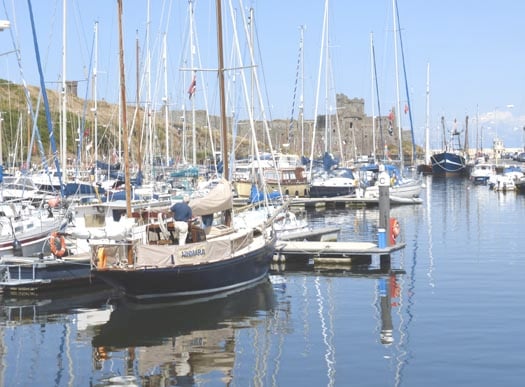
High summer in the Isle of Man. Looking seaward down the inner harbour at Peel towards the castle. Photo: W M Nixon
It was the ideal scenario for a plague-like outbreak of harbour rot, but as already reported here on August 24th, we made an immediate point of visiting the world's oldest yacht, at her abode in the characterful old port of Castletown before contemplating anything else. And then between the jig and the reels we saw a lot of this fascinating island by many different means of transport, only drawing the line at the ancient tram which runs between Douglas and Ramsey, because even for the most easy-going cruising man, it is just too slow.
Perhaps it's there to offset a central part of Manx culture, the TT motorcycle jamboree. The tram may well be a deliberate reminder of the slow and safe life, but the TT is all about fast and dangerous, and it's almost a religious cult. With the quaint little winding roads, the Isle of Man is probably the only place in the world where the tourism authorities will object if the road engineers want to straighten out a particularly dangerous corner.
One of our ship's complement of three, Brian Law, is a mad keen biker, so he really was in seventh heaven, but we kept him grounded with more sedate ways of travel such as the little old very smoky narrow gauge steam railway which runs from Douglas eventually to Port Erin - and don't forget to start your journey with the fireman's breakfast off a shovel in Douglas station.
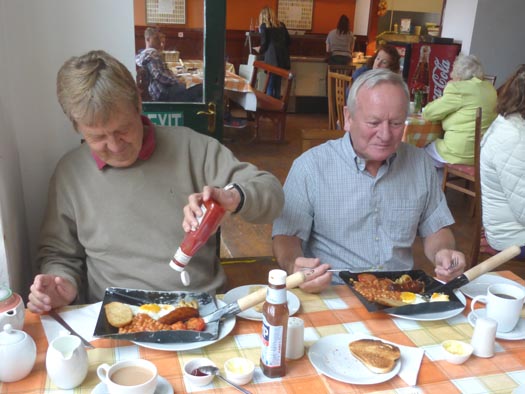
The only way to start the journey – the Fireman's Breakfast in Douglas Station, served on a shovel. Photo: W M Nixon
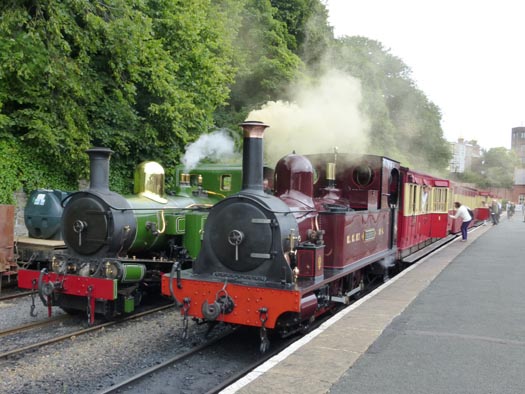
The Peel to Port Erin Express. Needless to say, each vintage compartment had a No Smoking sign. Photo: W M Nixon
But having done the island from end to end, the crew of Ainmara would like it to be known that the best way to cruise the Isle of Man is up front on top of a double-decker bus. Much of the island scenery is a sort of miniaturised Ireland or Scotland, so at first it seems completely bizarre that urban double-deckers run on many of the routes. And up top, it has to be admitted that at times the old bus gets a mighty wallop from a tree branch. But the views are marvellous, you get to meet a fascinating array of the locals, the bus will take you scenically to an extraordinary variety of towns and villages, and at day's end you return to Peel, the most characterful place of all, and there sits your boat serenely off the inn, and the party just getting going. It's cruising perfection.
And for anyone into traditional or classic or just interesting boats, Peel is paradise. We'd got the flavour of it as we'd arrived in the sunshine of a perfect summer's day on the Wednesday, going through the narrow entrance with Mike Clark's Manx nobby White Heather – traditionally rigged with huge lug mainsail – to starboard, while to port beside the harbour office was the superbly restored varnished Ray Hunt-designed 57ft Drumbeat, originally built for Max Aitken with twin centreboards – one for each tack – back in 1957, and newly arrived as an Isle of Man resident after her second total restoration.

Mike Clark's restored Manx nobby White Heather sets the classic lug rig.

The superstar of 1957. The restored Drumbeat with her varnished hull is a new resident of the Isle of Man. This view is looking seaward towards the Outer Breakwater over the footbridge and gate flap at the entrance to Peel Inner Harbour with its marina. Photo: W M Nixon

Peel's marina has revitalised this former fishing port. Photo: W M Nixon
Peel has always had something special, and since it got its gate flap in 2005 and the 124-berth marina three years later, the harbour area has been on the up and up, and the maritime community spirit in the town is a real tonic. We got our first taste of it that night in the Peel Sailing and Cruising Club where there was a merry buzz and a sense of anticipation with greetings for many old friends already there, and more on the way with the clubhouse affording a fine view of the outer breakwater, above which the upper rigs of gaffers could be seen as they headed for port in the last of the evening light, providing an entertaining guessing game as to which boat would be revealed as they swept past the outer end.
In the morning the harbour was sunlit and lively with more boats which had come in on the midnight tide. We finalised our entry and found that as were to do our duty by making a holy show of ourselves during the Parades of Sail for the delectation of the public, our hosts in turn would feed and water us in port, with the makings of breakfast put aboard each morning, and a fine feed for all crews each night in the Masonic Hall, the only place in Peel big enough to cater for the crowd.
All this hospitality at the Peel Traditional Boat Weekend involved many people and several organizations with a raft of sponsors, so it was a bit difficult to keep track, but as the two days of sport afloat had their timing dictated by the opening of the gate-flap, it was literally a case of going with the flow and enjoying yourself.
The basics of the weekend's administration were provided by Mike Clark of the traditional Manx Nobby White Heather and his PL 2013 team, but while they with their access to the Masonic Hall had the space for the crowd scenes, Andy Hall the Commodore of Peel S & Cr C and his many volunteers provided an additional key focal point in their fine clubhouse. So we'd all these delightful folk making a massive and very effective voluntary input to our enjoyment, and that was before we acknowledged the contribution of the top honchos of the various Old Gaffer Associations from all round the Irish Sea.

Mike Clark of White Heather heads up a remarkable squad of volunteers to make the Peel Festival a success. Photo: W M Nixon
Peel is a natural centre to draw in boats from Scotland, Ireland north and south, North Wales, and northwest England, so much so we had to stop ourselves thinking it was like a conference of Sub-Saharan African states, as the gathering was eventually to include Their Excellencies the Presidents or Senior Plenipotentiaries of Nioga, Dboga, Nwoga and Soga. More boats came in on every tide with more than 70 finally in the fleet, and as they wouldn't be able to get out across the gate-flap until late morning next day (Friday August 9th) for the first Parade of Sail, there was ample time in the sunshine to inspect the gathering in its glorious variety.
Stu Spence's 1875-vintage Pilot Cutter Madcap from Strangford Lough was in, recently back the Isles of Scilly where they'd renewed the rudder stock after breaking it west of Brittany, and steering themselves unaided by the cunning use of trailed buckets all the way to Scilly, where with considerable ingenuity they fixed the rudder. The crew for this remarkable feat included noted Isle of Man sailor Joe Pennington whose own restored Manx longliner Master Frank was another of the stars of Peel.
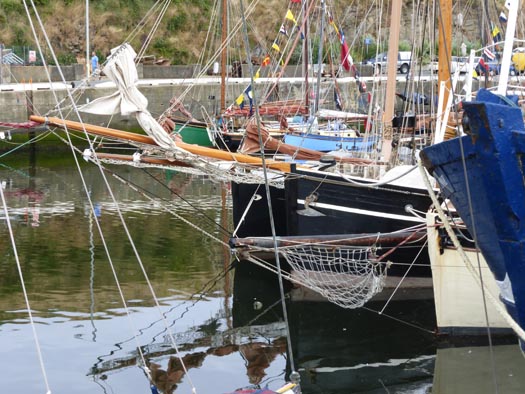
"Dock probes". Bowsprits were everywhere – these are on Mona, Vilma and (foreground) Madcap Photo: W M Nixon
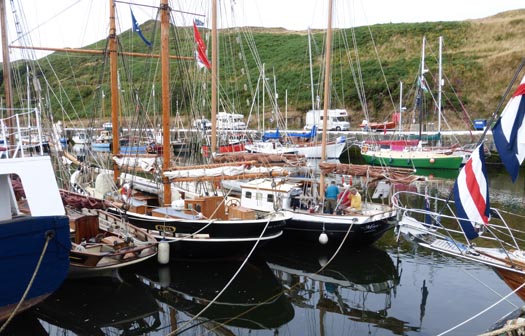
The sterns came in all shapes and sizes – these are (left to right) Madcap, Vilma and Mona Photo: W M Nixon
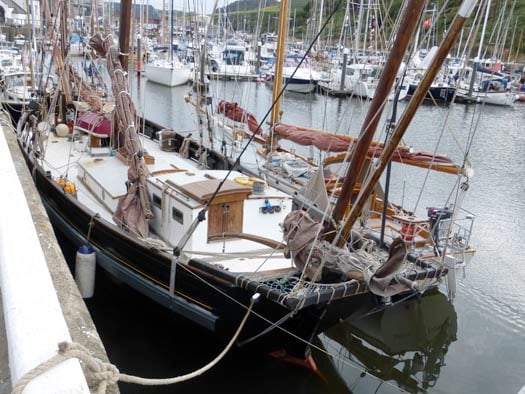
The Bisquine-rigged Peel Castle from West Cork, and outside her the Warington-Smyth cutter Dreva from North Wales. Photo: W M Nixon

We still await a photo which does justice to the West Cork-based Bisquine-rigged Peel Castle under sail (it would need to be in a lot of wind). Meanwhile, this one of her setting up her spars gives some idea of the eccentric rig which Graham Bailey has installed. Photo: W M Nixon
Ingenuity on a massive scale had also been involved in the creation of Graham Bailey's lugger Peel Castle from West Cork, which despite her name was originally a 50ft Penzance fishing boat built in Cornwall in 1929, but had been so named because Peel Castle was a familiar landmark for the roving Penzance fleet, and it is also the title of a much-loved fishermen's hymn. Though built as a motorized vessel, this fine vessel effectively had a sailing hull, thus when Graham bought her in 1999 he was acquiring a traditional sailing hull just as new as he could get. He spent nine years restoring and converting her at Oldcourt on the Ilen River, rigging her as an eye-catching French bisquine. With three masts in a fan configuration, she certainly looks unusual, but her sailing record speaks for itself, as she has cruised the length of the Mediterranean to Greece, and was in Peel in the latter stages of a three-month round Ireland cruise with extras which had already included a detailed cruise of the Hebrides and a passage out to St Kilda.
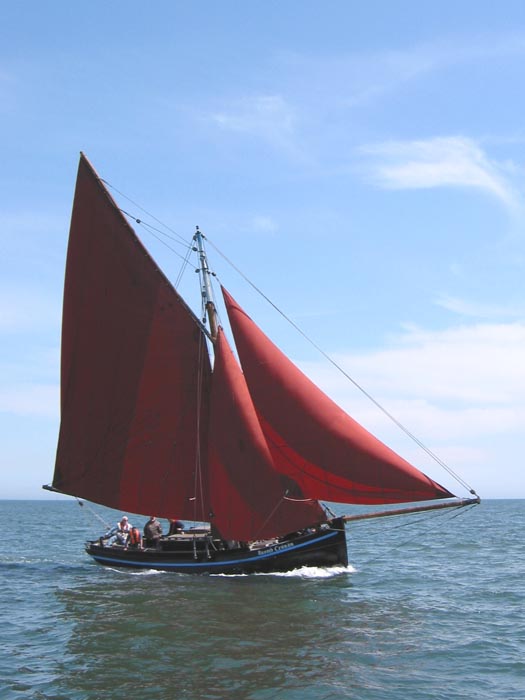
The Galway Hooker Naomh Cronan was built in Clondalkin, West Dublin, by a co-operative which still functions successfully after 15 years. Photo: W M Nixon

The Albert Strange yawl Emerald sailed south by Scottish owner Roger Clark was one of many smaller craft taking part in Peel 2013. Photo: Carol Laird
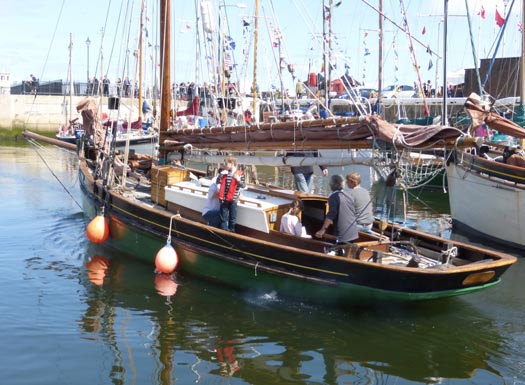
Joe Pennington's Manx longliner Master Frank is the sole survivor of a once numerous Ramsey-based sailing fishing fleet. Photo: W M Nixon
Irish traditional boats were flagshipped by the big Galway Hooker Naomh Cronan, which has been built and kept going for a remarkable 15 years by a co-operative based in Clondalkin in West Dublin, while the long story of Welsh slate schooners was represented by Scott Metcalfe's Vilma from the Menai Straits. She may have started life in 1934 as a ketch-rigged Danish sailing fishing boat, but when Scott and his wife Ruth restored the hull at their boatyard in Port Penrhyn on the Straits, they fitted her with a classic Welsh schooner rig, with the square sails aloft on the foremast mainly handled from deck. The hull certainly shows Vilma's Baltic origins but her rig, as we were to see when the Parade got going, is very much Welsh schooner, and apparently easy to handle, though that may have been the skill of the crew.

Vilma was one of the stars of the show. Photo: Carol Laird
Finally the gate-flap opened later than expected on the Friday morning, and those who were up for the Parade – not everyone by any means – went out onto a lively sea with the sun coming and going and a good breeze sweeping in from the west. Provided we didn't have to go to windward, Ainmara could carry full main, and so long as we kept reaching, she could carry jib tops'l too. So with Brian on the helm, she reached up and down in all her finery, and though we had to throw the outer tack a couple of miles out in a rumbly seaway each time we shaped up to parade back towards Peel, when nearing the shore on the inward track we asked our helmsman to tack as far up the outer harbour as he could at the inner turn in order to provide the smoothest possible water for elderly gentlemen hopping about the deck to clear sheets.

Zapping along – Ainmara at full speed as she shapes her course in towards Peel Castle and the circuit of the Outer Harbour. Photo: W M Nixon
Being a biker, Brian is an ace close quarters helmsman, and each time coming in he brought Ainmara right into the upper reaches of the outer harbour as though he expected to go straight on up the main street. Then a long elegant curving tack, and out we went again with everything setting to perfection before open water was reached, and the old girl outsailing everything else large and small, all great fun.
We'd more of the hospitality that evening with a substantial supper in the Masonic Hall and a great session in the sailing club with Adrian Spence and Joe Pennington in fine form as they detailed their experiences in getting the rudderless Madcap in to Hughtown from somewhere off Ushant, and then a blow-by-blow account of the re-installation of the re-built rudder.
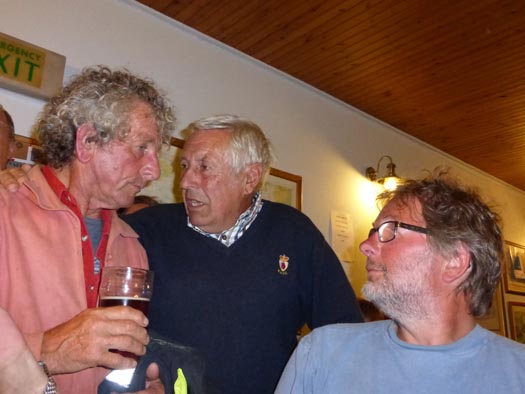
Everybody has a right to their opinion....Joe Pennington, Dickie Gomes and Adrian "Stu" Spence in conference in Peel S & Cr C. Photo: W M Nixon
The Peel people were as good as their word in putting the makings of breakfast on board each morning, but they had started gently enough with standard bacon and egg and the usual extras on the Friday. Then Saturday started the grown-up breakfasts, with a bag of magnificent Manx kippers placed into the cockpit. Our captain became the kipper skipper. We were pleasantly surprised at how much of a dab hand our master and commander was in cooking them lightly to perfection, and by the time we got back from the island, it was difficult to imagine starting the day any other way.
That Saturday (August 10th) was a sort of public interaction day, and included a "dirty boatbuilding" competition beside the harbour, with each team being given enough material to build a small boat – well, not so much a boat, more something that would just about float - then they were given a time limit to finish. The whistle blew to start, it blew again to signal time up, and the winners were the first team whose crewed boat managed to get across the harbour. They had all the teams they needed, though few enough old gaffer owners took part, as they reckoned most of their winters were spent like this, and they'd prefer to do just about anything else, while for Ainmara's crew, it was the day of the great steam train ride.
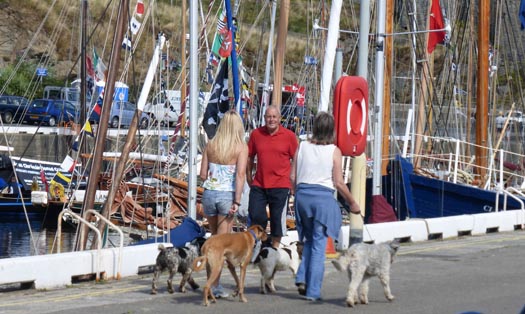
It may be the Peel Traditional Boat Weekend, but walkies are still expected. Photo: W M Nixon
Back in Peel for the Saturday night festivities, Andy Hall, Commodore of the Peel S & Cr C (which is twinned with Down Cr C) had told us not to eat ourselves silly early on, as the real feasting would take place in his club from 9.0 pm onwards. It was a masterwork of voluntary enthusiasm. His members threw themselves into preparing a mountain of queenies (the succulent Manx queen scallops) cooked six different ways, and a very eclectic clientele (for this seems to be one of the highlights of the Manx social calendar) threw themselves into a massive over-consumption in which all pretences at dining delicacy went by the board. We ate ourselves to a standstill with strangers now the best of friends, but it wasn't an exceedingly late night, for with a week's supply of protein taken aboard in one go, we'd to go back to the boat at a reasonably early hour to sleep it off.
It must have all been cooked to perfection, for there were no ill effects in the morning (Sunday August 11th) and we could breakfast off the skipper's kippers with relish. But while our guts were well settled, the weather was anything but. Though a passage home was a possible if rugged proposition for that Sunday with a fresh to strong sou'wester expected, strong west to nor'wester forecast for the Monday would have meant a dead beat, and no go at all for ancient craft.
We were all three on a three-line whip to be back by Monday night. So instead of taking part in Sunday's Parade of Sail, Ainmara returned across the Irish Sea while we could. Even if it did involve a demanding slug of a passage, it was a shrewd move, for anyone from the east cost of Ireland who stayed until Monday didn't get back until Tuesday.
It was a couple of weeks before news of the awards filtered through. Not surprisingly, both Vilma and Peel Castle received major trophies. But as we'd been a no show in the second Parade of Sail, it was a complete surprise that Ainmara had been awarded the Creek Inn Trophy for Best in Show for her one appearance on the Friday. It was the jib tops'l wot done it. All credit to Mike Sanderson of Sketrick Sails for making the old girl a very elegant set of threads. It was a sweet ending to two seasons of centenary celebration.
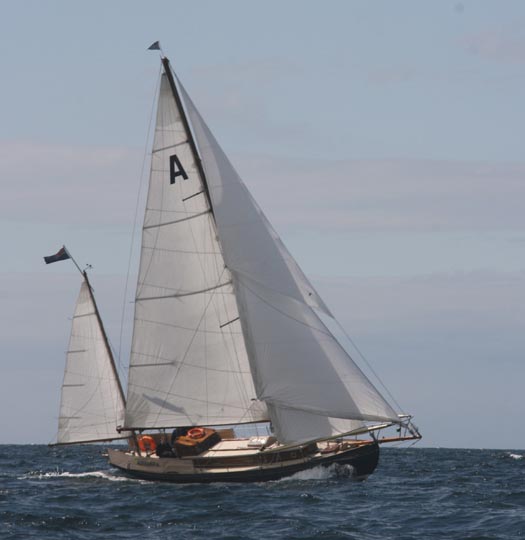
"It was the jib tops'l wot done it......" Ainmara in fine form, on her way to winning the Creek Inn Trophy for 'Best in Show'. Photo: Carol Laird
Irish Sailing 2014 Preview – A Good Year Coming up? Why Not?
With a good selection of excellent sailing weather once the summer had finally set in, 2013 defied economic recession to produce a memorable season in Ireland, with a strong emphasis on World Championships and other high profile events. W M Nixon wonders if 2014 can keep up the pace.
Blasts from the past are a feature of many of 2014's planned championships, causing us to reflect on why classes and events wax and wane over the years. A GP 14 Worlds coming up on 10th-15th August on Strangford Lough? Time was when we won such things. The 40th Anniversary Scottish Series at Tarbert on the achingly beautiful waters of Loch Fyne? In recent years, there has been a disturbing decline in numbers taking part in this unique event, including those from Ireland. Yet during a certain glorious period of massive turnouts, top Irish boats of international renown provided a string of overall champions.
As for the continuation of the revival of ISORA Racing in the Irish Sea, with interesting new additions to the programme? Well, it's definitely happening, but we've still a long way to go to revive the heady days of the 1970s, when ISORA was the new kid on the block and thriving mightily, with the best year seeing 107 boats competing in a championship which was spread over seven weekends throughout the season, each weekend featuring a very well-supported offshore event, usually complete with an overnight element in the racing, involving logistics which might see some crew members away from home for four days – and all that just for one offshore race.
And as for multihulls being high on the global sailing interest stakes after the advent of the MOD 70s and the new-look America's Cup, the Formula 18 Worlds 2014 at Ballyholme in July (5th-11th) will be bringing one of the world's best-established catamaran classes to frontline prominence in Ireland. Introduced in France in 1994, and taking hold so rapidly it received international status by 1996, the Formula 18's 2013 Worlds at Marina di Grosseto on the west coast of Tuscany in Italy saw a fleet of 161 boats hail French national champion Billy Besson as the new World title-holder after he saw off the challenge of Britain's Hugh Styles. Best of the Irish were Ballyholme's Adrian Allen and Brian Swanston, who were also part of a team promoting the 2014 Worlds at their home club with the full support of North Down Borough Council.
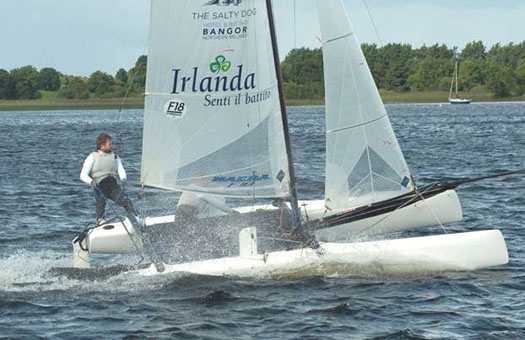
The Ballyholme Formula 18 which spread the word about the 2014 Worlds on Belfast Lough at the 2013 Worlds in Italy.
It's Ballyholme YC which also produced some of Ireland's top performers in the GP 14s at World level, with Bill Whisker winning the global title in 1974. And there's a certain unexpected connection towards another event in the recollection - it was a young East Down YC skipper, Richard Croasdaile, who was the first overall champion in the inaugural Scottish Series way back in 1975, racing the Nicholson 30 Kavala II. Mathematical pedants will be pleased to note that 2014's big party in Scotland (it's from May 23rd to 26th) marks the 40th year, not the 40th birthday, which will be in 2015. So the Croasdaile win was in both the First Year and Year Zero. And anyone who thinks it doesn't matter much either way has clearly never been involved in the minutiae of sports and particularly club history.
Be that as it may, Nick Stratton's win in Scotland in 1977 with Hydro-Djinn also had strong Irish links, but the event really hit the big time in 1981 with fleet numbers rocketing and the overall winner Frank Woods of the National YC's new Tony Castro 36f t One Tonner Justine III, skippered by Harold Cudmore.
Justine III went on to win the One Ton Worlds at Royal Cork that same year, but it was some time before Royal Cork boats became heavily involved in the Scottish Series. There was a Cork presence at the top in 2003 with the local Tarbert-based Cork 1720 King Quick (Ruairidh and Graeme Scott) taking the overall title. But then for four years with the Scottish Series at its height of success, Ireland and particularly Cork swept the board at the top, with Anthony O'Leary's first Antix (a Corby 36) winning in 2004, then Tim Costello of Dublin Bay's first Mills-designed Tiamat won in 2005, then in 2006 it was Antix again, and the fabulous run of success (more than somewhat connected to the Celtic Tiger years) concluded with the overall title in 2005 going to Conor Phelan's Mills 40 Jump Juice from Cork.
The pace of expansion of the Scottish Series almost continually from 1975 onwards meant that older events suffered, none more so than the traditional annual race round the Isle of Man which had always been staged in that final holiday weekend of May, but saw its once high entries totally eclipsed. However, now that numbers have eased back so markedly in the Scottish event (which can, after all, be a very long trek for Irish boats) the Isle of Man as a destination if not a circuit is re-appearing in Irish Sea offshore events, which in 2014 will see an ISORA Programme which tries to be as user friendly as possible while optimising links to other events.
Obviously the Irish Sea's two offshore highlights in the first half of the season are the ICRA Nationals at the RIYC from Friday June 13th to Sunday June 15th, and the Round Ireland from Wicklow on Saturday June 28th, but a crew minded to have the webbed-foot way of life can take full advantage of the 2014 programme planned by ISORA Commodore Peter Ryan and his Committee to log a formidable amount of sailing, though with defending overall champion Stephen Tudor of Pwllheli on top form with his J/109 Sgrech, just getting into the frame would be quite an ambition in itself.
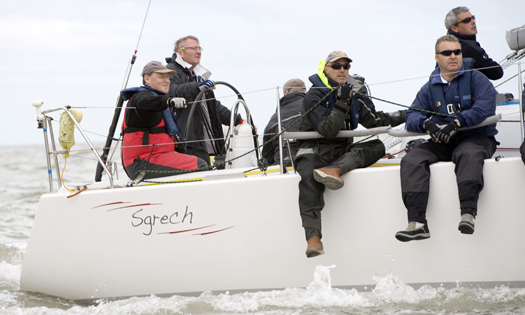
Stephen Tudor's J/109 Sgrech set the pace in ISORA racing in 2013. Her skipper is one of the key movers in the new Welsh IRC Nationals from August 1st-3rd at Pwllheli
The Isle of Man is back in the picture with the historic Tranmere SC Midnight Race to Douglas from the Mersey area re-emphasised on Friday June 6th, while Sunday June 8th sees a day race from Douglas to Dun Laoghaire. Meanwhile for those who have stayed on in Ireland, June 7th sees Howth's annual Lambay Race, the premier regular Fingal sailfest, with defending champions Windsor Lauder and Steph Ennis with the vintage Club Shamrock Demelza - in Neville Maguire's ownership, Demelza was ISORA Champion in 1984.
For those determined to sail on with a spot of high culture after the ICRA Nationals from June 13th to 15th, the Royal Alfred YC is staging its annual Bloomsday Regatta on Monday June 16th, which still leaves a spare weekend for the countdown to the Round Ireland on Saturday June 28th.
Defender in that is the Guoy family's Ker 39 Inis Mor, which races in Ireland under Clifden Boat Club colours. In winning 2012's Round Ireland, Inis Mor snatched victory from Piet Vroon's Ker 46 Tonnere de Breskens, but Tonnere then went on to have a fabulous season in Irish waters by sweeping the board at Cork Week.
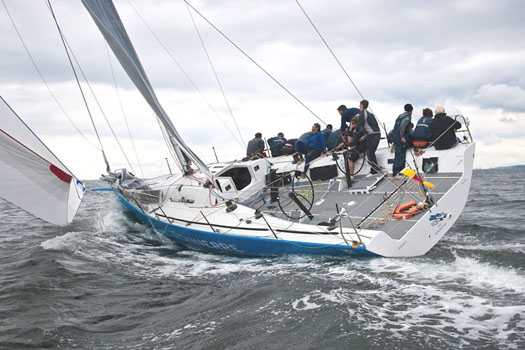
Piet Vroon's Ker 46 Tonnere de Breskens storming along to be overall champion at Cork Week 2012. Photo: Bob Bateman
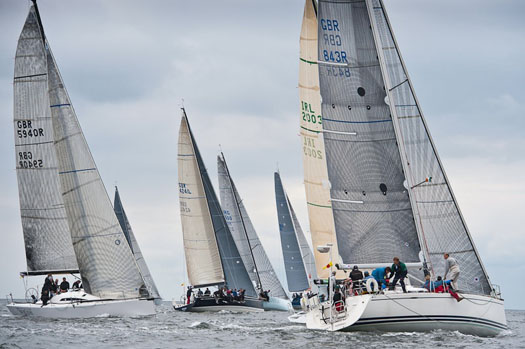
Big boat start at Cork Week 2012. Cork Week 2014 will be in a more compact form, with practice races on Monday July 5th, and the series proper from Tuesday July 6th to Friday July 11th. Photo: Bob Bateman
Cork Week 2014 is from Tuesday July 8th to Friday July 11th, but there's a full programme of practice races on the Monday (July 7th). Racing Chairman Anthony O'Leary and RCYC Admiral Peter Deasy are acutely aware of the need to offer an attractive economical package, and this new slimmed-down look has emerged from research with regular participants, and an in-depth analysis of what is working elsewhere.
With July fully under way, other aspects of life afloat start to come centre centre stage, and July 5th to 13th sees the 85th Anniversary Cruise of the Irish Cruising Club along the coast of southwest Ireland. It concludes at Glengarriff on Sunday July 13th, for it was in Glengarriff on 13th July 1929 that a cruise-in-company of just five yachts brought the ICC into being. The club held a massive Cruise-in-Company with Transatlantic participants in 1979 to celebrate its Golden Jubilee, and it has since held many other waterborne events, both in Ireland and abroad. But even though the members seem to live for ever, some very distinguished ones reckon it's unlikely they'll be around for the Centenary in 2029, so the 85th Anniversary – with the fleet capped at 85 boats – seemed a good idea, and already the word is that boats signed up have pushed through the thirty mark.

Glengarriff, birthplace of the Irish Cruising Club in 1929. The 85th Anniversary of the ICC will be celebrated here at the conclusion of a Cruise-in-Company on July 13th 2014.
Among the sailing highlights of 2013 were the Golden Jubilee Celebrations of the Old Gaffers Association, in which the Irish Sea set a pace few other areas could match. Although there will be OGA events in Ireland in 2014 (and the word is of a branch being formed in Cork Harbour), obviously the pace won't be quite as hectic as 2013. But if you've a mind to savour the old gaffer and traditional boat movement at its colourful and eccentric best, get yourself to Peel on the Isle of Man around 25th to 28th July, when the Peel Traditional Boat Weekend is one of the best maritime festivals of them all.
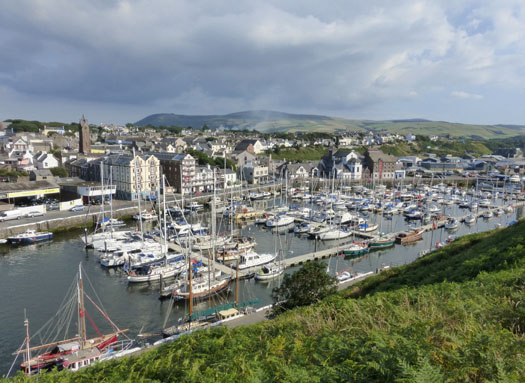
Peel in the Isle of Man. Its Traditional Boat Weekend (July 25th to 28th) is one of the maritime highlights of the classic boat scene in the Irish Sea. Photo: W M Nixon
However, for those who prefer racing with three-sided sails, one of the most beautiful coastal areas in all Ireland will be the venue for the WIORA Championships at Mayo SC on Clew Bay from July 23rd to 26th. Unless you've a boat small enough to trail, it's a long sea haul from other centres, but ICRA Commodore Nobby Reilly has made the brilliant suggestion that the SailFleet J/80s should all be taken to Mayo SC for this championships, with top offshore clubs then nominating junior crews to race them on Clew Bay.
A new event, the Welsh IRC Nationals at Pwllheli, ushers in August, and it's very handy for boats from the east coast of Ireland, with marvellous sailing waters against the gorgeous backdrop of Snowdonia. Dates are 1st to 3rd August. As the 4th is a Bank Holiday in Ireland, it's very time-friendly, and with Stephen Tudor in a key role, the only extra requirement for a very classy event is for the weather to play its part.
Back in Ireland meanwhile, time-honoured events such as the West Cork regattas in the first half of August and the Cruinniu na mBad (the Gathering of the Boats) at Kinvara on Galway Bay at mid-month are always guaranteed to provide sport and entertainment at many different levels, but for serious racing people the focus from August 10th to 15th is on Strangford Lough and the GP14 Worlds at East Down YC.
It will make for an interesting comparison with the Formula 18 Worlds at Ballyholme a month earlier. There's no doubt the Formula 18 is becoming an important part of the DNA of world sailing. But will it ever become part of Irish sailing's DNA in the same way as the GP14? Classes come and go more slowly in Ireland than elsewhere, but they do come and go nevertheless. Yet the GP 14 shows every sign of going on for ever in the Emerald Isle, and the 2013 Irish Nationals at Sutton DC on Dublin Bay at the end of August was a triumphant blast of the past, the present and the future.
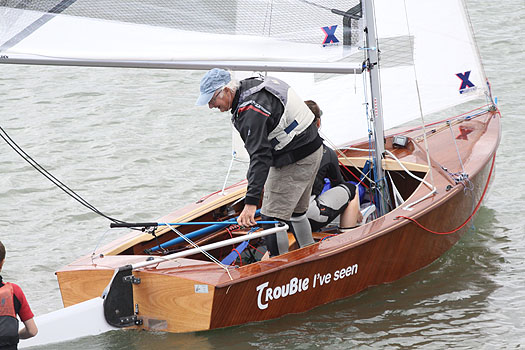
Ever-young old stager. Curly Morris of Larne sails forth in his immaculate GP14 at the Nationals in Sutton at the end of August. Photo: Ron Maher
SDC Commodore Andy Johnston and his team hosted a friendly group of keen racing folk who revelled in the sport their lovingly-prepared boats provided, while the Hill of Howth, after a dry and sunny month, provided a background which looked more like one of the isles of Greece than somewhere on Ireland's east coast.
It was a festival for ever-young old stagers, with Curly Morris of Larne turning up with his immaculate wooden boat Trouble I've Seen to provide a taster for the calibre of the fleet we'll see on Strangford Lough in August 2014.
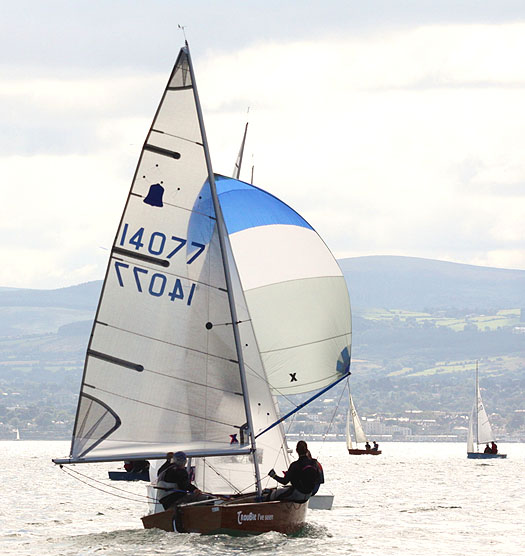
They just keep sailing along.......Veteran skipper Curly Morris raced the GP14 Irish Nationals at Sutton in August 2013 in anticipation of the August 2014 Worlds on Strangford Lough. Photo: Ron Maher
2014 Irish Sailing's Key Dates
May 23rd to 25th Scottish Series
June 6th-8th ISORA Tranmere-IOM-Dun Laoghaire races
June 7th Lambay Race
June 13-15th Dun Laoghaire ICRA Nationals
June 16th Bloomsday Regatta
June 28 Wicklow SC Round Ireland Race
June Derry's Clipper Round the World Race stopover
July 8th-11th Cork Week
July 5th-13th ICC 85th Anniversary Cruise-in-Company to Glengarriff
July 5-11th Ballyholme YC Formula 18 worlds
July 20 Dun Laoghaire's Optimist Europeans
July 23 to 26th WIORA Championship, Mayo SC
July 25th to 28th Peel Traditional Boat Weekend
August 1st to 3rd Welsh IRC Championship Pellheli/Abersoch
August 10th-15th East Down YC GP14 World Championships
September ISAF Worlds in Santander, Spain (first opportunity to qualify for 2016 Olympics)
Irish Sailing 2013 Review – Ups & Downs & Sideways Too
In this Irish Sailing review of 2013, W M Nixon looks back on a year of the unexpected. There were reversals of fortune where some top sailors had seemed set for success, but new stars emerged to provide hope for the future. And perhaps best of all, after a gruesome start, the weather relented at mid-summer to provide one of the best sailing seasons in years.
Thanks to the diaspora of Irish sailing talent with the Paddy presence continually increasing in Australia, these days we effectively have a year-round sailing season, and major southern hemisphere events like the Sydney-Hobart are seen as an associated part of the year's events at home.
Thus New Year's Day has the useful distraction of a leisurely perusal of the results from Hobart, and January 1st 2013 was most satisfactory. Gordon Maguire may not have repeated his overall win of the 2011 race with Stephen Ainsworth's superb 63ft Loki, but he was tops of his class, comfortably out-sailing every boat of comparable size, and his second overall to Bob Oatley's hundred footer Wild Oats XI (which had also established a new course record) meant that the Irish skipper was confirmed as clear overall winner of the Australian Offshore Championship 2012-2013, a very satisfactory conclusion to the five year Ainsworth-Maguire partnership
Back home meantime, winter was tightening its grip, and even the hyper-keen Fireballs frost-biting in Dun Laoghaire found their turnouts occasionally down to single figures, though the Lasers in Howth in their 38th winter season found numbers holding up well, with prizes well spread among several Leinster clubs. The growing turnout including sailors whose fathers – and possibly even grandfathers – had sailed in that first Laser league way back in 1974. Ronan Cull won the Standards, Aoife Hopkins the Radials, and Daragh Sheridan won the Grand Masters.
But for most sailing folk, January and February are for hibernation with just the occasional emergence to honour some notable achievement from the previous season, and better still several previous seasons. So it was a very special AGM of the Irish Cruising Club in February in Dun Laoghaire when Fergus & Kay Quinlan of Bell Harbour on Galway Bay took the premier trophy, the Faulkner Cup which dates back to 1931, for the third year in a row for their exemplary global circumnavigation in the 12 metre cutter Pylades, which Fergus built himself in steel.
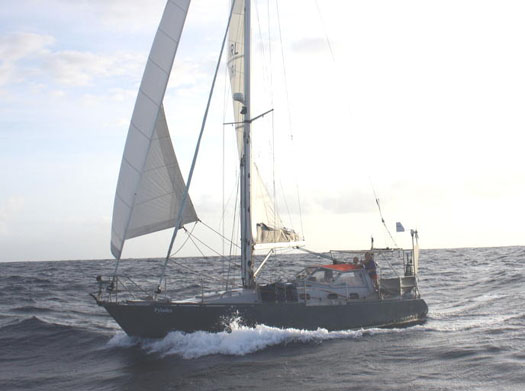
The homemade success – Fergus and Kay Quinlan's 12m van de Stadt-designed Pylades
Winter showed little sign of easing in Ireland in March, but the sailing in the Caribbean area was at its best, and at the Star Class 86th Bacardi Cup series in Miami, Cork's Peter O'Leary was right in the hunt for a podium place in the fleet of 63 boats. But having to carry a 27th after he'd discarded a 36th meant he finished 8th overall, despite his scorecard including a 1st, 2nd and 6th.
So it was a junior brother of the O'Leary clan of Crosshaven, young Rob, who was most in the sailing headlines in March, as he stood down from sailing in the Universities Team Racing Championship over the St Patrick's Weekend in mid-March at Tralee Bay SC in order to put all his efforts into organising this Firefly racing in Kerry for 28 teams which included international input.
Rob O'Leary was trebly rewarded for his altruism, for in a weekend when the rest of Ireland was suffering snow and storms, somehow Tralee Bay had its own very sailable micro-climate. And the crowded programme was handsomely completed, with the organiser having the satisfaction of seeing his own squad from University of Limerick, captained by Ross Murray, emerge as champions.
Ross Murray captained the winning University of Limerick team in the Irish Universities team Racing Championship at Tralee Bay over the St Patrick's Weekend in mid-March.
Then in the following month O'Leary had his chance at the helm, and he took it in style to make Limerick the winners of the Student Yachting Worlds Selection Trials, raced over four Saturdays in April in the SailFleet J/80s at Howth. University College Dublin having won the SYW in October 2012 by a huge margin, they'd a place as of right in the 2013 Worlds, thus Limerick were in theory poised to make the Irish 2013 challenge even more formidable. But as we shall see, the ephemeral nature of college sailing personnel meant that April 2013 was really when Irish college sailing was at its peak for the year.
There was no easy optimism about the new season during May, as a bitterly cold Spring hampered sailing enthusiasm. However, the big winds which often came with the low temperatures suited Olympian Annalise Murphy racing at the Delta Lloyd Spa Regatta in the Netherlands, and she won Gold in style. But those rugged conditions were daunting for others, particularly among the dedicated contingent sailing to the Scottish Series in wintry headwinds. Conditions relented during the event itself, but Irish boats missed out on the frame, though Liam Shanahan's J/109 Ruth, largely crewed by junior instructors from the National YC, was well in contention.
Summer arrived suddenly at the end of May, just in time to provide 24 boats of the Cruising Association of Ireland with idyllic conditions for a Cruise-in-Company to North Wales. Back home in Dublin Bay, that first Bank Holiday Weekend of June had fine weather for the visit of the Old Gaffers Association, celebrating their Golden Jubilee with a rolling Round Britain Cruise which came far enough west to take in Dublin and Belfast.
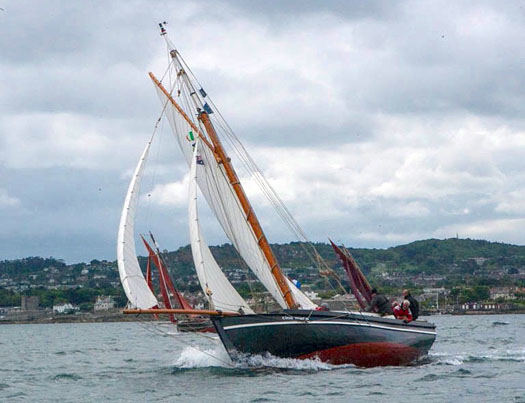
The Old Gaffers Race in Dublin Bay. This is Dutch skipper Rik Janssen's own-built steel Galway Hooker Cine Mara developing full power. Photo: Barry O'Loughlin
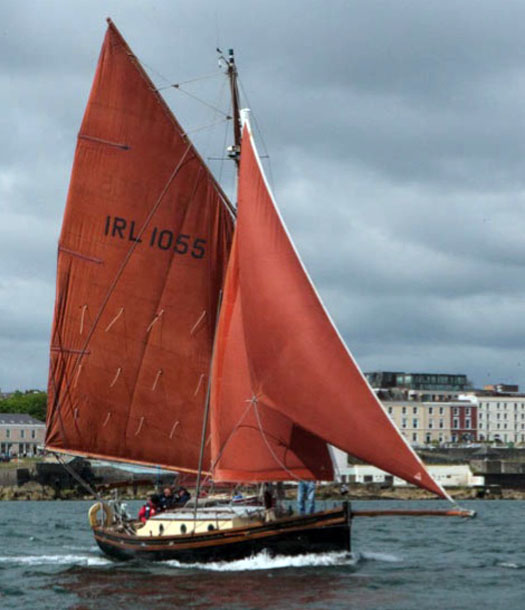
Sean Walsh of the Dublin Bay OGA won the Golden Jubilee Race Series in the bay with his Heard 28 Tir na nOg by taking third in the Leinster Plate, and then winning the Asgard Trophy. Photo: Barry O'Loughlin
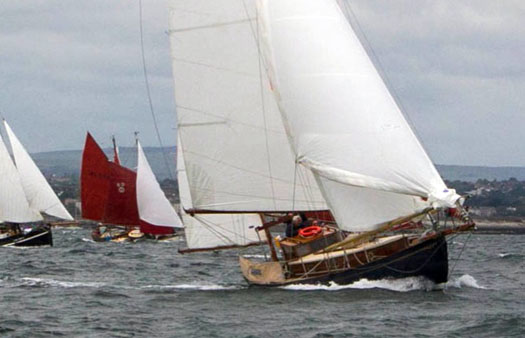
Dickie Gomes' 101-year-old Ringsend-built 36ft yawl Ainmara from Strangford Lough on her way to winning the Leinster Plate race staged by Poolbeg Y & BC of Ringsend. It was the first time Ainmara had been back to Ringsend in 90 years. Photo: Barry O'Loughlin
It was Dublin Bay – thanks in part to the involvement of the 115-year-old Howth 17s – which provided more gaff rigged boats than anywhere else except the final Golden Jubilee assembly in the Solent in mid-August, and with Dublin Bay's racing tradition, they'd sport afloat, ashore, and in the River Liffey. DBOGA stalwart Sean Walsh with his Heard 28 Tir na nOg got the best overall result by winning the concluding race for the Asgard Trophy, and taking third in the opening race for the Leinster Plate, where the winner was Dickie Gomes's 101 year old 36ft yawl Ainmara from Strangford Lough, celebrating her return to her birthplace of Ringsend after an absence of 90 years.
The biennial Dun Laoghaire to Dingle Race got going on Friday June 7th with a good fleet of 22 boats, and for much of the race it looked as though RORC flag officer Anthony O'Leary of Crosshaven was going to take both line honours and the handicap win with his Ker 39 Antix. But a parking lot for the leaders in Dingle Bay saw results being inverted to provide an exuberantly celebrated victory for Tralee Bay's Brian O'Sullivan with his veteran Oyster 37 Amazing Grace.
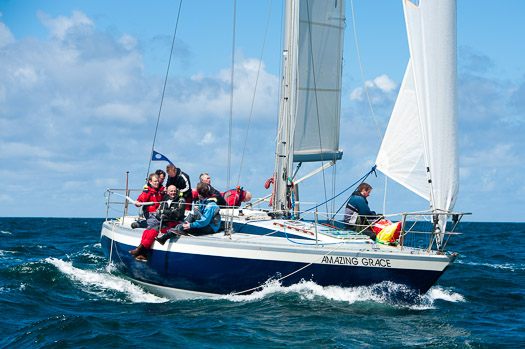
Brian O'Sullivan's vintage Oyster 37 Amazing Grace racing in the ICRA Nationals in Tralee Bay after winning the Dun Laoghaire-Dingle Race overall. Photo: Bob Bateman
It was ironic that Tralee benefited from this brief calm off Dingle, for the middle weekend of June saw a distinct and savage kink in the weather with some very rugged conditions for the ICRA Nationals at Tralee Bay itself. That said, when the sailing was good, it was very good indeed, and with the ICRA event moving on seamlessly from the WIORA championship, a good turnout saw some excellent sport with the new Xp33 Bon Exemple helmed by Colin Byrne of Dun Laoghaire proving best of the visitors, while the veteran Dehler Optima 101 Dis-a-Ray (Ray McGibney, Foynes YC) put in an excellent performance across the two championships combined to maintain the honour of the Atlantic seaboard.
The uneven conditions in June as the summer of 2013 slowly settled into place had also provided brisk conditions at the Skandia Sail for Gold Regatta at the former Olympic venue at Weymouth, and the Irish squad revelled in it, with northern duo Ryan Seaton and Matt McGovern developing the promise shown at the Olympics 2012 to take Gold in the 49er, while Annalise Murphy took Bronze.
That spell of foul weather at mid-June also made things difficult for an Irish Cruising Club rally to the Isles of Scilly, but despite very unfavourable conditions crossing the Celtic Sea, 14 boats out of an intended 19 reached those enchanted isles, and the programme was largely completed. There was still plenty of breeze about when the large multihulls from France in the Routes des Princes arrived in Dun Laoghaire, but even so normal DBSC Saturday afternoon racing was busily under way when the big multis called off their racing after spectators were treated to the first of the MOD 70s' two capsizes in 2013. It was a publicist's dream, having something as spectacular as this happening on a Saturday afternoon in a natural ampitheatre like Dublin Bay, but it wasn't much fun for the crewman who sustained a badly fractured pelvis which resulted in a summer spent unexpectedly in Tallaght Hospital. And as for the jolly boaters of DBSC, they just carried on racing.
It took some time for the weather to renew its promise of early June, so there was still plenty of breeze about when a new event made its debut, RIOTI on Lough Ree on Thursday June 27th. There has been talk for years of an alternative to the biennial Round Ireland Race from Wicklow, but 2013 was when it finally happened. Lough Ree is as near the middle of Ireland as you can get, it's eminently suitable to race round, so the first Round Ireland On The Inside Race was staged by assorted eccentrics in some style, with Pat Mahon's Folkboat Ventus (Lough Ree YC) winning the cruisers, while Frank Browne of Portlaw in County Waterford won the Shannon One Designs, and Ian Malcolm of Howth led the Water Wags in an event which deserves to become a classic, and maybe even an annual one.
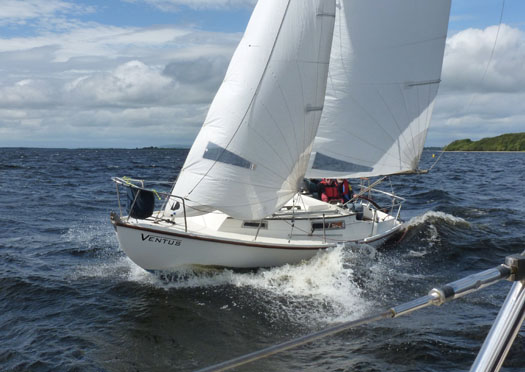
Pat Mahon's Folkboat Ventus (Lough Ree YC) won the cruiser class in the new RIOTI Photo: W M Nixon
Down on the south coast, meanwhile Commodore Cameron Good and his members opened their much improved clubhouse for Kinsale YC nicely in time for the Sovereigns Cup at the end of June, which saw a welcome return of wall-to-wall summer weather and glorious racing for crews many of whom were still licking their wounds from the rugged racing on Tralee Bay. But though it was basically an IRC and ECHO racing festival, it was the gallant veterans of the 1720 Sportsboat class who stole the limelight, with Olympian Peter O'Leary turning in a stellar performance with Spiced Beef to win the overall prize.

Superb racing in the Sovereigns Cup Photo: Bob Bateman
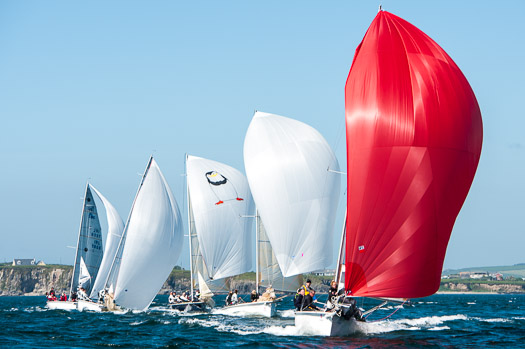
"They haven't gone away you know...." In fact, far from fading away, the Cork 1720s produced the winner of the Sovereign's Cup. Photo: Bob Bateman
July found the summer settling itself in comfortably over Ireland, and entries for the Volvo Dun Laoghaire Regatta accelerated as the dates approached and people realised that this "ultimate suburban sailfest" offered a very convenient opportunity to make hay while the sun shone. Which it did, and big time too, for the entire event. Though some of the 400 or so competing boats (120 of them visiting) might have enjoyed more breeze, skilled race officers used the special effects provided by tides and sea breezes to complete a busy programme for an astonishing total of 13 classes, with Nigel Biggs' classic Rob Humphreys Half Tonner Checkmate XV being best overall with a clean sheet to prepare her for victory in the World Half Ton Classics in France in September.
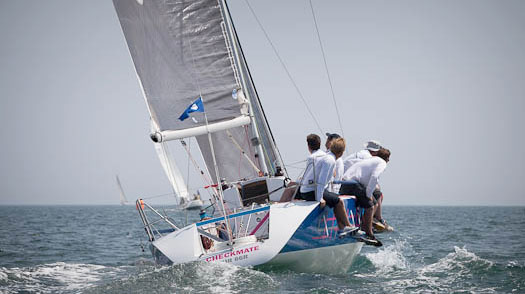
The vintage Half Tonner Checkmate XV (Nigel Biggs) was top scorer in the huge fleet in the Volvo Dun Laoghaire Regatta in July, and then went on to win the Half Ton Classic Worlds. Photo: Aidan Tarbett
VDLR 2013 – OVERALL RESULTS.
IRC CLASS 0 1. Grand Cru II (J McGarry) 2. Zephyr (S Cowie) 3. Dark Angel (A Ackland)
IRC CLASS 1 Bon Exemple (X Yachts GB) 2. Now or Never 3 (N Sandford) 3. Rockabill V (P O'Higgins)
IRC CLASS 2 1. Checkmate XV (N Biggs) 2. Scenario Encore (S&J Fitton) 3. Tribal (L Burke)
IRC CLASS 3 1. Quest (Cunningham & Skerritt) 2. Kilcullen Euro Car Parks (Howth YC K25 Team) 3. Nyah (S Hyde)
J109 1. Joker II (J Maybury) 2. Storm II (P Kelly) 3. Jalapeno (Barrington/ Burke/ Phillips)
SIGMA 33 1. White Mischief (T Goodbody) 2. Leaky Roof (A Harper/ E&K Robertson) 3. Rupert (R&P Lovegrove)
BENETEAU 31.7 1. Levana (J Mitton) 2. Prospect (C Johnston) 3. Levante (M Leahy/ J Power)
IRC Coastal 1. Aquelina (S&J Tyrell) 2. Wow (G Sisk) 3. Mermaid IV (S Fitzpatrick)
NON-SPINNAKER 1 1. Bite the Bullet ( C Bermingham) 2. White Lotus (P Tully) 3. Orna (P Dilworth)
NON- SPINNAKER 2 1. Demelza (S Ennis) 2. Vespucci (S&K O'Regan) 3. Nauti-Gal (J&J Crawford)
Ruffian 23 1. Diane 2 (A Claffey/ C Helme) 2. Ruff Nuff (D Mitchell) 3. Bandit (Kirwan/ Cullen/ Brown)
Shipman 1. Curaglas (J Masterson) 2. Gusto (C Heath/ G Mills) 3. Whiterock (H Robinson)
SB20 1. Should Be? (M O'Connor) 2. BomChickaWahWah (J O' Driscoll) 3. Seriously Bonkers 3 (M Cuppage/ P Lee)
RS ELITE 1. Storm (J Gunning/ S Polly/ D Kelso) 2. Momentary Laps... (J Patterson) 3. Toucan (G&M Vaughan)
BENETEAU FIRST 21 1. Chinook (A Bradley/ P Morgan) 2. Yikes (J Conway) 3. Carna (S Spence)
DRAGON 1. Phantom (P Bowring/ D Williams) 2. Jaguar (M Byrne) 3. Diva (R&R Johnson/ R Goodbody)
Flying Fifteen 1. The Gruffalo (I Matthews) 2. Melliffluence (B Mulligan) 3. The Big Bow Wow (N Meagher/ N Matthews)
GLEN 1. Glenluce (R&D O'Connor) 2. Glendun (B Denham) 3. Glenariff (A Lee)
HOWTH 17 1. Isobel (B&C Turvey) 2. Oona (P Courtney) 3. Pauline (S O' Doherty/ E Ryan)
Fireball 1. Let's Get Messy (B Byrne) 2. Tipsey McStagger (C&J Clancy) 3. Goodness Gracious (L McKenna/ F Rowan)
IDRA 14 1. Starfish (A Carr/ D Kilroy) 2. Delos ii (P O'Neill) 3. Slipstream (J Ascoop/ H Keenan)
MERMAID 1. Tiller Girl (J O'Rourke) 2. Jill (P Smith/ P Mangan) 3. Endeavour (R Bannon)
SQUIB 1. Why not (D Jago) 2. Iola (F Whelan) 3. Perfection (J Fleming)
WATER WAG 1. Mollie (C MacAleavey) 2. Swift (G Kilroy) 3. Pansy (V Delaney)
Sail Fleet J80 Bay Challenge 1. More Mischief (E Doyle) 2. Katie (T Dunne/ F Fahy/ C McGuinness/ D Grace) 3. Xerxes (D O'Neill)
PY 1. IRL 171 426 (F Devlin) 2. IRL Return of the Milky Bar Kid (H Sheehy) 3. UG (R O'Leary)
After this fabulous saltwater festival of racing, the July focus turned to classic boats and then fresh water, with first the Glandore Classics in West Cork, and then the month rounded out with the Mirror Worlds on Lough Derg. The diversity at Glandore was as evident as ever, with the lovely Fife ODs from the Menai Straits making a remarkable impact, but it's in no way a down-grading of the other boats to state that the runaway star of the show was the centenarian Jolie Brise. The famous French-designed and built pilot cutter won the first Fastnet Race in 1925, and she and her crew from Dauntsey's School made a special point of coming to Glandore so that they could have a properly emotional rounding of the famous rock.

The Centenarian pilot cutter Jolie Brise, winner of the first Fastnet Race in 1925, rounds the Fastnet Rock in commemoration during the Glandore Classic Boat Regatta 2013. Photo: Brian Carlin
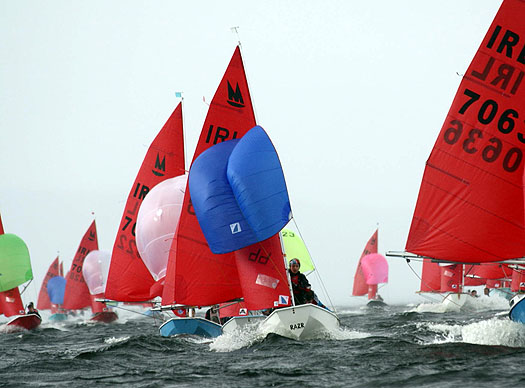
Fabulous sport in an interesting selection of Irish weather – the Mirror Worlds in Lough Derg. Photo: Gerardine Wisdom
As for the Mirror Worlds 2013, what can we say? Everything you've heard about this great event is true. It did indeed muster an international fleet of 93 boats. The hospitality was undoubtedly laid back yet certainly superb. The sailing was Irish sailing at its very best, with Lough Derg in a lively mood. It did indeed go right down to the wire, with the young South African siblings crew of Ryan and Michaela Robinson winning from Ridgely Ballardes and Rommel Chavez from the Philippines. And yes, they did manage to get a senior government minister to perform the official opening ceremony. They pulled off this coup by discovering that Minister for Agriculture and the Marine Simon Coveney harboured a secret ambition to sail a Shannon One Design. The word was he'd do anything, even opening a sailing event on a Sunday evening at some considerable distance from his constituency, just to achieve this. Sailing a Shannon OD at Dromineer on Lough Derg? No problem. The Minister got his SOD sail. The event got its gala opening. And the racing was brilliant.
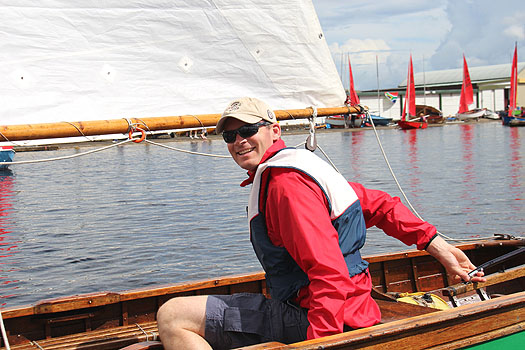
Government minister Simon Coveney achieves his dram of a sail in a Shannon One Design. Photo: Gerardine Wisdom
August is traditional the month for sailing elsewhere. The 81-year-old 17ft Mermaids erupted from their East Coast and Shannon Estuary strongholds upon Galway Bay Sailing Club at the start of August for their week long championship, and it was encouraging that one of the youngest teams – Skerries SC's Mark Boylan crewd by Niall Collins and Aileen Boylan – emerged as winners from a fiercely contested series, with Jim Carthy of Rush second, Paul Smith of RIYC third, and Jonathan O'Rourke (NYC) fourth.
Despite the fact that Dun Laoghaire had two helms in the top four, and the excellent turnout and great Mermaid sport at VDLR when Jonathan O'Rourke had won, the word is that Mermaid turnouts in Dun Laoghaire's regular racing have become so sparse that DBSC won't be providing them with a class in 2014. Perhaps with so much energy being focussed on the Water Wags, glossy Dun Laoghaire only has enough enthusiasm for one traditional clinker-built class.
Meanwhile at other places beyond the seas, August had its time-honoured international biennial festival of the sea, when boats have long since been turned away from a rapidly-filled entry list. 350 of them went off from Cowes in the Fastnet Race on Sunday August 11th, with a goodly Irish contingent among them. But it was very much of the year of the French, with father-and-son crew of Pascal and Alexis Loison on the JPK 1010 Night and Day making history as the first overall winners racing in the two-handed division.
Best of the Irish to win the Gull Salver was Martin Breen's Reflex 38 from Galway Bay SC, which sailed as Discover Ireland under the command of Aodhan Fitzgerald. It tells us everything about how completely international the Fastnet has become by noting that the Galway boat, while 18th overall, was actually fourth overall among boats from Britain and Ireland.

The Galway-based Reflex 38 Discover Ireland was top Irish boat in the Fastnet.
While traditional August regattas proceeded apace at venues on every Irish coast, as the month rolled on the preparations were finalised for major international events in Kinsale, Crosshaven, Dun Laoghaire and Howth. With his election in November 2012 as President of the International Disabled Sailing Association at the ISAF Conference in Dun Laoghaire, John Twomey of Kinsale was soon at work knowing that he could count on his home port to provide the special support for staging the IFDS Worlds, putting in place a programme which came to brilliant fruition in ideal weather
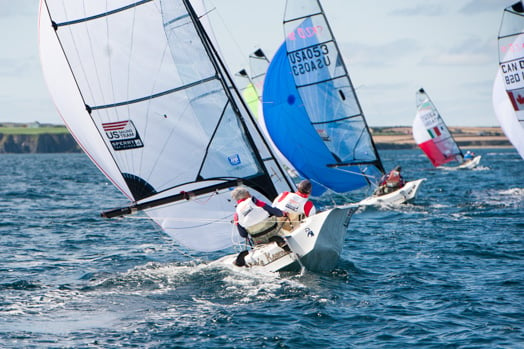
Summertime off Kinsale – racing for the Skud class in the IFDS Worlds 2013. Photo: Bob Bateman
In a good year for global events in Ireland, it was one of the most truly international. The Skud class saw Britain's Alexandra Rickham and Niki Birrell win from Italy's Marco Gualandris and Marta Zanetti, while Canada's John McRoberts was third. In the 2.4s, the winner was the Netherlands' Bijlard Guus, with Germany's Helko Kroger second, France's Damien Sequin third and Australia's Matt Bugg fourth in the numerically strongest fleet – forty-five 2.4s sailing out on the blue Kinsale sea. And in the Sonar, where in times past John Twomey has himself been among the medals, the winner was France's Bruno Jourden with The Netherlands' Udo Hessels second and Australia's Colin Harrison third, while John Twomey was best of the Irish at ninth – crewed by Anthony Hegarty and Ian Costelloe – in a fleet of 18 boats.
Round on the east coast at Howth, a lengthy buildup to the BMW J/24 Worlds 2013 had seen some locals take on board the suggestion that a very reasonably priced second hand market means these iconic little sloops could be acquired for a small layout. And then with elbow grease and sailing determination, you could be in the hunt at world level in a class which prides itself on its economical approach to top class sport.
Well, as the fleet gathered, it soon became obvious that some nations' versions of "economical approach" is another nation's notion of stratospheric expenditure. Ironically, however, in view of who is currently at the top of Europe's economic tree and who is towards the bottom, the impoverished Irish found themselves most at one with the German contingent. Germany will be hosting the J/24 Worlds in a couple of years times, so three young German crews turned up with their boats in Howth to test the water. And far from renting luxury waterfront houses as accommodation for the duration of the championship, all they wanted was somewhere to pitch their old bell tents.

The J/24 Worlds 2013 at Howth – who would think this photo was taken less than ten miles from Dublin city centre? Photo: David Branigan
The word from J/24 International is that Irish race officers are held in high regard, and David Lovegrove's performance at Howth through an extraordinary variety of weather further reinforced this view. Despite losing one day completely to calms, he put through the full programme, the racing was marvellous, and the US crews were in top form, though at least the winner, Tim Healy of Newport RI, was clearly an American of Irish descent. Defending champion Mauricio Santa Cruz of Brazil was second, while another US helm, Travis Odenbach from Rochester NY was third, having fallen from the grace of overall lead on the final day. And with the last race won by Germany's Tobias Feuerherd, who knows but success for the worlds in 2015 in Germany may already be a-building for the home team.
As for other classes in late August and early September, it was the ever-young Laser all the way in both Cork Harbour and Dublin Bay. The Vodafone Laser Nationals at the Royal Cork from August 22nd to 26th produced a very healthy spread of results in the Standard Rig division, with Chris Penney of East Antrim winning from Alan Ruigrok of Rush, while Russian visitor Maxim Nikolaev was third and Philip Doran of Courtown took fourth.

Gold Medallist. Annalise Murphy is borne ashore after her mighty win.
The Laser parade then moved on to Dublin Bay, and shifted up several gears to become the Europeans hosted by the National YC. While the Men's Standard Class was limited to 120 boats, with all the different divisions afloat the fleet total was pushing towards the 340 mark, an exercise in logistics which is almost beyond comprehension. Fortunately, some good Irish results brought clarity, with Annalise Murphy triumphing to win Gold in the Women's Radials, while 17-year-old Finn Lynch won Gold in the Under 21s, Silver in the Europeans, and Bronze in the Men's Radials.
This youthful achievement in September was boosted at the end of the month in Germany on Lake Constance, where the Irish Team in the European Under-23 Match Race Final was skippered by Philip Bendon of Baltimore to the Gold Medal. His crew were James Bendon, Christopher Tiernan and Bruno van Dyke, and their good showing kept British skipper Mark Lees back in second, while the Italian crew took the bronze.
Moving into October, Irish prospects for the Student Yachting Worlds were beginning to look a bit flaky. The French hosts had greatly tightened the format, moving the event to the no-nonsense venue of Pornic in Brittany, and down-sizing the boats to J/80s. Theoretically this should have favoured the two-pronged Irish campaign, as the SailFleet J/80s were readily available for intense training, but the economic realities of discerning post-college career paths poutweoighed the attractions of endless sailing opportunities, and by August it was clear that University of Limerick would not be availing of their right to be the Irish challengers, while defenders University College Dublin had seen changes in personnel such that they had little enough in the way of crew battle-hardened by previous SYWs.
Nevertheless the UCD crew, with Philip Doran as helm, gave it their best shot, while Dublin City University, as runners-up in the selection trials, took over the Limerick place at short notice and under skipper Ryan Scott, they assembled a crew entirely from the junior membership of Howth YC. Out of fifteen teams, with the French very much in control to win overall with Switzerland second and the US third, the Irish had to be happy with 8th and 9th, while the "Howth nippers" drew some additionl concolation from the news that clubmate Laura Dillon had skippered the winning team in the British Women's Open Match Racing Championship.
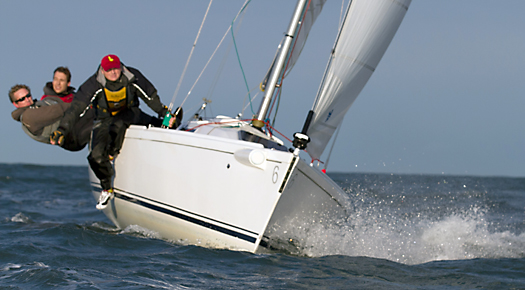
Ben Duncan on his way to winning the all-Ireland. Photo: Aidan Tarbett
October saw select keelboat classes descend on Lough Derg for their traditional Autumn Regatta at Dromineer, and further lustre added to the achievements of Irish SB20 champion Ben Duncan, who had a runaway win in a class which has revived itself in Ireland with a bootstraps operation during 2013. He then went on to win the Helmsmans Championshjp raced in the SailFleet J/80s in Howth at the end of October. The weather was going haywire with the buildup to the St Jude's Day storm, so it reflects all credit on both participants and the race management team that a full programme was put through in just one day, with a break in the middle to allow a vicious little front to go through. In fact, the race officer worked the weather window so well that all the photos seem to show glorious perfect sunny sailing. Seafra Guilfoyle of Royal Cork was runner up, with FF Champion Ian Mathews of the National third.
The Autumn saw the focus shifting towards the Mediterranean, and it brought success for Cork's David Kenefick in the Figaro Solo Circus. After various ups and down throughout the season in Atlantic waters, the Mediterranean Autumn programme saw it go down to the wire for the coveted Rookie of the Year title, and the final races saw everything go Kenefick's way to be the first Irish winner.
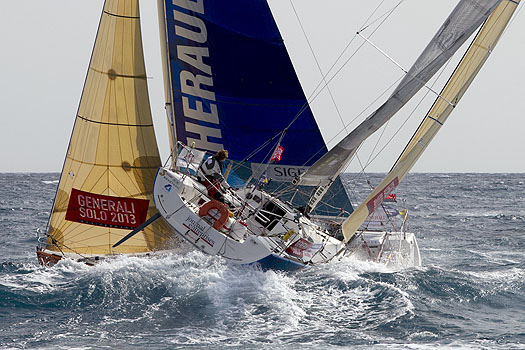
David Kenefick was Rookie of the Year in the 2013 Figaro Solo programme.
In recent years there has been Irish success in the Middle Sea Race out of Malta in late October-early November in the two-handed division, but for 2013's race a couple of the leading Irish two-handed teams threw in their lot with the fully-crewed Maltese-owned J/122 Otra Vez. It was a shrewd career move. They won Class 4, and placed 11th overall in a fleet of 97 boats. Next best of Irish interest was Dermot Cronin's First 40.7 Encore from Malahide, which finished exactly at mid-fleet.
Into November, and interest moves even further southward and even warmer, with the 360-mile Duba to Muscat Race. Adrian Lee's Cookson 50 Lee Overlay Partners, overall winner of the first RORC Caribbean 600 Race in 2009, and overall winner (as Ger O'Rourke's Chieftain) of the 2007 Fastnet, goes into the Muscat race as favourite, and doesn't disappoint, with a new course record too.
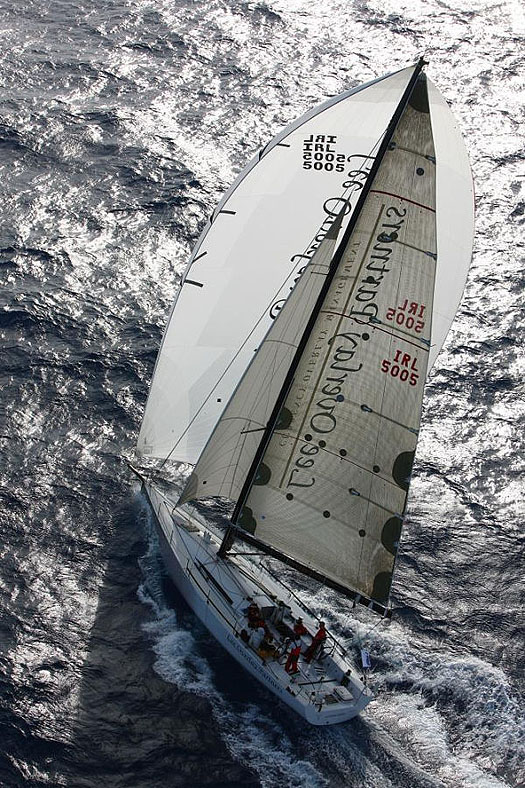
Adrian Lee's Cookson 50 Lee Overlay Partners on her way to comprehensive victory in the Dubai-Muscat Race. Photo: Tim Wright
And meanwhile out in Australia, a new Dubai-built 60ft Ichi Ban for legendary owner Matt Allen is emerging in preparation for the Sydney-Hobart 2013, starting December 26th. Among the team involved in this ultimate racing machine is Gordon Maguire. Which seems to be where we came in...
For more on 2013's Irish sailing highlights read Afloat's Sailor of the Month Awards
Bob Fisher, leading sailing writer and the supreme authority on the America's Cup, brought an inspiring vision of the highest peaks of the sport to the Royal St George YC's 175th Anniversary Champions Celebration last weekend. W M Nixon delves into the backstory of one of global sailing's true greats.
#americascup – There's a dilemma underlying the remarkable career of Bob Fisher. He is one of the best sailing writers in the world. He is probably the very best writer about yacht racing in the world. And he is the undisputed global authority on everything to do with the America's Cup – its history since the first race in 1851, its litany of extraordinary characters with their many wrangles, its technical advances, and its remarkable and sudden ultimate rise to become an event of truly global status during the 34th Series in September 2013 in San Francisco.
The dilemma? Well, The Fish is a true sailing polymath. For sure, he writes vividly about our sport. Yet he is also a talented racing dinghy builder – his own-built boats have won championships to international level. But he is also an extremely good sailor himself. Thus in his long career of writing about sailing, he has probably been a better natural racing sailor than about 98% of the people whose sailing achievement he happens to write about.
All of which explains his "absorbing interest" in the America's Cup, and his ability to produce the defining stories about it. For it is only at the America's Cup that Bob Fisher is best deployed as the reporter, commentator and historian while others do the sailing.
At other events during his long and varied career - he is now 77 - he has often been an active and successful participant in addition to being the man who files the stories at the end of the day's racing. And with this frequent personal involvement in the racing afloat and the apres sailing ashore, sailors see him as one of their own rather than a media person of whom they should be wary. Thus he can come up with the true inside stories which bring his words to life, raising them above reportage to become the vivid defining narrative of sailing as it really is.
Quite how he manages to do it is beyond most folk's imagination. He is doing enough to provide about half a dozen people of more ordinary energy levels with full time careers. Yet although there must have been times when the pace verged on being too hectic to handle, when you meet him participating and reporting in sailing events, or at a special sailing social gathering like the 175th Anniversary Champions Party at the Royal St George YC, it is to find you are undoubtedly in the presence of a great man, but also a man who enjoys it all to the full, with wide and civilised interests in many aspects of human life.
The notion of the 175th Anniversary of the Champions of the George originally came from Johnny Ross Murphy, and when he got friends and fellow members like the master-delegator Brian Craig, plus Derek Jago and Paul Maguire on side, the thing just grew and grew until with a group chaired by Craig, with the efficient Ciara Dowling making sure the nuts and bolts were in place, they worked at a list of who was eligible to be there.
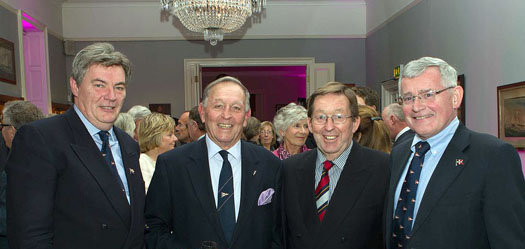
At the Royal St George YC 175th Anniversary Champions Night were (left to right) Don O'Dowd (Rear Commodore (Sailing) R StGYC), Bob Fisher, Winkie Nixon, and Commodore Liam O'Rourke. Photo: Gareth Craig
They managed to go back 62 years, and the final total was 597 major winners of one sort or another, from Dublin Bay champions right up to ten Olympic sailors. On the night, the target figure of 250 attendees had been long since surpassed, and with diligent research they had unearthed some top performers from a very long time ago. Yet it was also very much of today, for even as we reviewed the achievements of 175 years, we were also thinking of RStGYC member Adrian Lee already on his way to establishing the new course record with his Cookson 50 in the 360-mile mile Dubai to Muscat Race, which had started that morning – his success raised the RStGYC major achievement tally to 598 almost before the party was over. At the same time, fellow member Damian Foxall was in Le Havre awaiting the start of the Transat Jacques Vabre 2013 as co-skipper on the MOD 70 Musandam-Oman, but Foxall had to go through frustrating days of waiting as the raced wasn't to start until Thursday November 7th.

Even as the RStGYC 175th Anniversary Champions Party was under way, club member Adrian Lee was bringing the major achievements list up to 598 with his success in the Dubai-Muscat Race 2013 with his Cookson 50 Lee Overlay Partners. Boat and owner were already in the list with their overall win in the inaugural RORC Caribbean 600 Race in 2009. Photo: Tim Wright
It was quite a night in Dun Laoghaire, and with some crews reunited after more than three decades, there was a lot of catching-up to be done and news to be exchanged. So it says everything about Bob Fisher's ability to convey the new excitement of the current America's Cup that he was able to get the full attention of people in their sea of nostalgia, with his presentation provided an excellent spicing for an evening which would otherwise have been just too totally club-focused.
Sharing the round table at the inter-speeches supper with The Fish, we found topics covered were wide ranging and not necessarily entirely about boats and sailing. But nevertheless it is Bob's boat-owning history, and his uses of his boats, with which the ordinary sailing Joe can most readily identify.
The word is that just about all the Fisher myths are gloriously true. He did indeed absolutely have to sell his own-built championship-winning Fireball at a major event in Switzerland in the 1960s immediately after winning and before departing the hotel, as he and his crew had neither the money to pay the hotel bill (which was enormous, this was Switzerland after all), nor the funds to get themselves home.
He did indeed win his first race at his birthplace of Brightlingsea in Essex at the ripe old age of two years and three months (he was skipper, working mid-cockpit, while his father was detailed off to be the helmsman). And currently at his adopted home port of Lymington on the western Solent, he does indeed co-own with Barry Dunning the 1895-built 40ft Solent One Design Rosenn, the sole survivor of what was probably the world's first one design keelboat class.
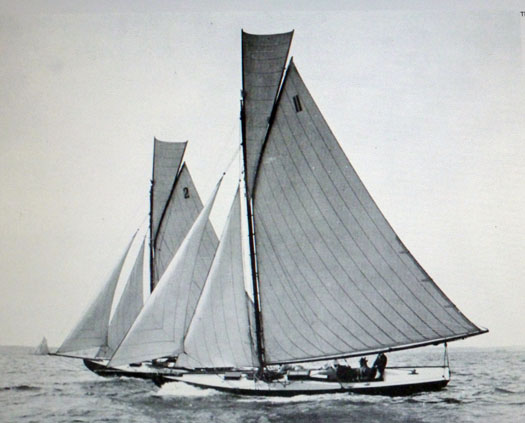
The Solent One Designs in their prime in 1895. They were probably the world's first proper one design keelboat.

The survivor – Rosenn (Bob Fisher and Barry Dunning) is the sacred relic of the Solent OD.
Thus it's likely that Bob and I were the only two members of the Old Gaffers Association at the 175th anniversary party in the George, as he now owns two gaffers, having given in to his crew's demand that while they can go along with gaff rig, sometimes they'd like to sail a newer boat. So he has obliged them by getting a boat three years younger than Rosenn, a lovely little Fife boat built 1898 which he has in Scotland in readiness for next year's 40th Anniversary Scottish Series, an event with which Bob has been closely associated since its inception.
It's the Scottish Series of 1992 which provides me with the most vivid image of Bob Fisher. Back in the 1980s, he was sailing consultant to the BBC soap Howard's Way, which was about the people – some good, some less so – running an expanding boatyard on the Hamble. To keep the series alive, the producers were looking for a new storyline which would take things in a believable direction, yet provide fresh excitement and business and technical problems with which a wider audience could identify.
Bob suggested that they should get the "yard" to start developing the building of a new-style Ultra Light Displacement Boat, a boat which would be big enough to provide accommodation of family cruising appeal, yet allied to a performance which would, in the ideal ULDB conditions, attract flat out racing types keen for sheer speed. The theory was that the human challenge in a project so far removed from the orthodox European boat type would create its own dynamic and drama.
He was given 48 hours to put the idea in a more concrete form. Now it so happened that some time earlier, he and Tony Castro had been doing a China Sea Race on a Castro-designed 40ft ketch, and though they could get her above ten knots on a good reach, hitting 11 seemed to be an insurmountable barrier. So in their frustration some very rough ideas were sketched out for a ULDB which would simply keep on increasing speed as the breeze built off the wind.
The rough drawings had been put away in a drawer and forgotten about, but after this script conference, Bob immediately phoned Tony Castro and asked him if he could find those drawings, and if so could he develop them up into a workable proposition for the day after tomorrow. More than a little midnight oil was burnt, but Castro came up with the goods, and the result was Barracuda, the 45ft prototype of the ULDB which in production went through various name changes, and was finally series built by Sadler Yachts as the Sadler Barracuda 45, with 19 being produced between 1985 and 1989.
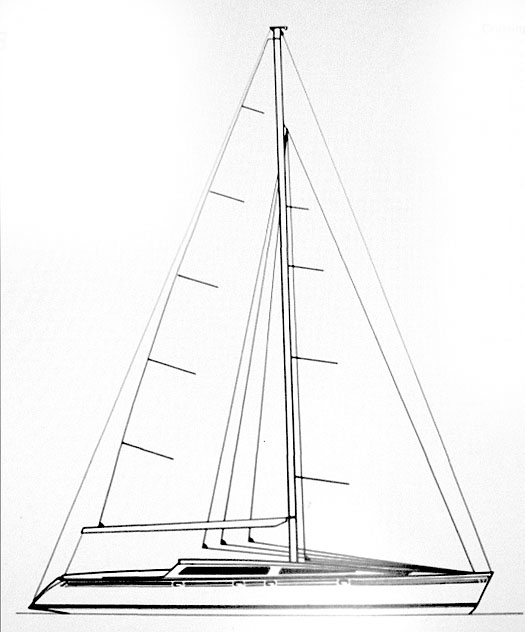
The above-water profile of the Sadler Barracuda 45 looked so normal it was a wolf in sheep's clothing, with the rig as shown only hinting at the fact that enormous masthead kites could be flown when conditions suited.

The hull profile gave a clearer indication of the boat's true character as a ULDB. The production boats had a hydraulically-raised keel, but Bob Fisher's prototype had a fairly straightforward heavily ballasted and very deep centreboard which was raised by a 3:1 tackle inside the centreboard case which was led to a winch on the cabintop. Two members of the crew were selected for the end-of-day centreboard-lifting grind with a double grip handle, and timed. The all-time record of 63 seconds was achieved by Bob and his exact contemporary Steve Lemon at Tarbert – "we wanted to get into the Islay Frigate asap"

The accommodation layout of the production Sadler Barracuda 45 suggests that the builders were unable to resist filling every corner, whereas a true ULDB will have minimalist accommodation, kept strictly admidships. Although few if any of the buyers of the 19 production boats went for the bath option, their boats all came out at least a ton heavier than Bob Fisher's own Barracuda of Tarrant.
They were a complex build project, with a hydraulically lifting bulb keel which in theory came up far enough for the boat to dry out level, tri-podded on her keel and twin rudders. And with so much space in the roomy hull around the keel housing, they even suggested fiilling an under-utilised gap on the starboard side with a miniature bath, but it's thought that few if any owners availed of this option.
But the timber-built prototype Barracuda of Tarrant herself certainly did the business in developing the storyline for Howard's Way, and she also provided Bob and his wife Dee with ten extraordinary and hugely enjoyable years of active ownership in which they covered tens of thousands of miles thanks in no small part to Dee's exceptional organisational abilities, and her willingness to ensure personally that the boat was at the desired venue and race-ready when Bob arrived in from covering some major sailing event elsewhere in the world.
It says much about the boat's versatility that in 1989 she proved ideal for the two-handed Round Britain and Ireland Race. Sailed by Bob with Robin Knox-Johnston, she scorched round the 2000 mile course to such good effect that she won her class without recourse to handicap, and finished ahead boat-for-boat of the boats in the next two classes above. It made for a change from a previous participation by Bob in this race, when he and Les Williams raced an 80-foot maxi whose sails were so heavy that in each stopover port, they'd to organise a farewell party so that guests could be spirited aboard the big boat in order to help with raising the mainsail.
But Barracuda by contrast provided the perfect combination of long-legged performance with manageable handling loads on both sheets and helm. Thus she frequently made the annual trek round Land's End and north to the Clyde for the Scottish series, and 1992 was a classic example. The main start for the feeder race to Tarbert was from Gourock, and I was crewing for my brother in his Belfast Lough-based Sigma 33. Back in 1992, the Sigma 33s were superbly fulfilling the Offshore One Design ideal, and heading south for Ailsa Craig on a beam reach in a brisk westerly, as the sun set we were streaking out past the Garrock Heads with at least 16 Sigma 33s in line abreast under spinnaker to leeward, and a dozen or so others in close attendance.
Offshore racing gets interesting when the sun sets, particularly so in one designs, for once the sun is gone, you're not allowed to luff. With 16 boats in line and competition intense in the Sigma 33s, there was more than a bit of mighty roaring (our skipper, my own brother, amazed me with his invective towards the boat next to us), leading in turn to shouted debates above the roar of the bow-waves as to how you define sunset on sailing water surrounded by mountains.
But then a great silver wraith came sweeping past as though the Sigma 33s were standing still, and all were briefly silent in admiration. It was Barracuda. Having started quite some time after us, she was zooming south in conditions she loved under an unbelievably large masthead gennaker, with the other boats in her class – some quite substantially larger – left many miles astern.
It was a magic vision in the special light of a long Scottish evening of late Spring. And it was made even more remarkable in that it seemed as though The Fish was sailing her single-handed. For there he was, unmistakable at the helm, his wonderboat perfectly under control with her twin rudders and sails beautifully trimmed, yet set up in such a way that the crew could retreat below for a mug of something hot as the cold Scottish night set in.
Bob and Dee's crews on Barracuda always seemed to be recruited from central casting to have strong characters to match their skipper. So it was entirely in keeping with the boat's style to imagine that they should have decided the skipper could be left on his own to steer the boat to match the setup of sails which briefly had the sheets made fast.
And in Barracuda's rapid passing, it left us the abiding image of Bob Fisher, stately at the wheel, monarch of all he surveyed, happily guiding his beloved dreamship as she swept onwards into the gathering night, with the glorious prospect of yet another wonderful sailing season stretching into the months ahead.
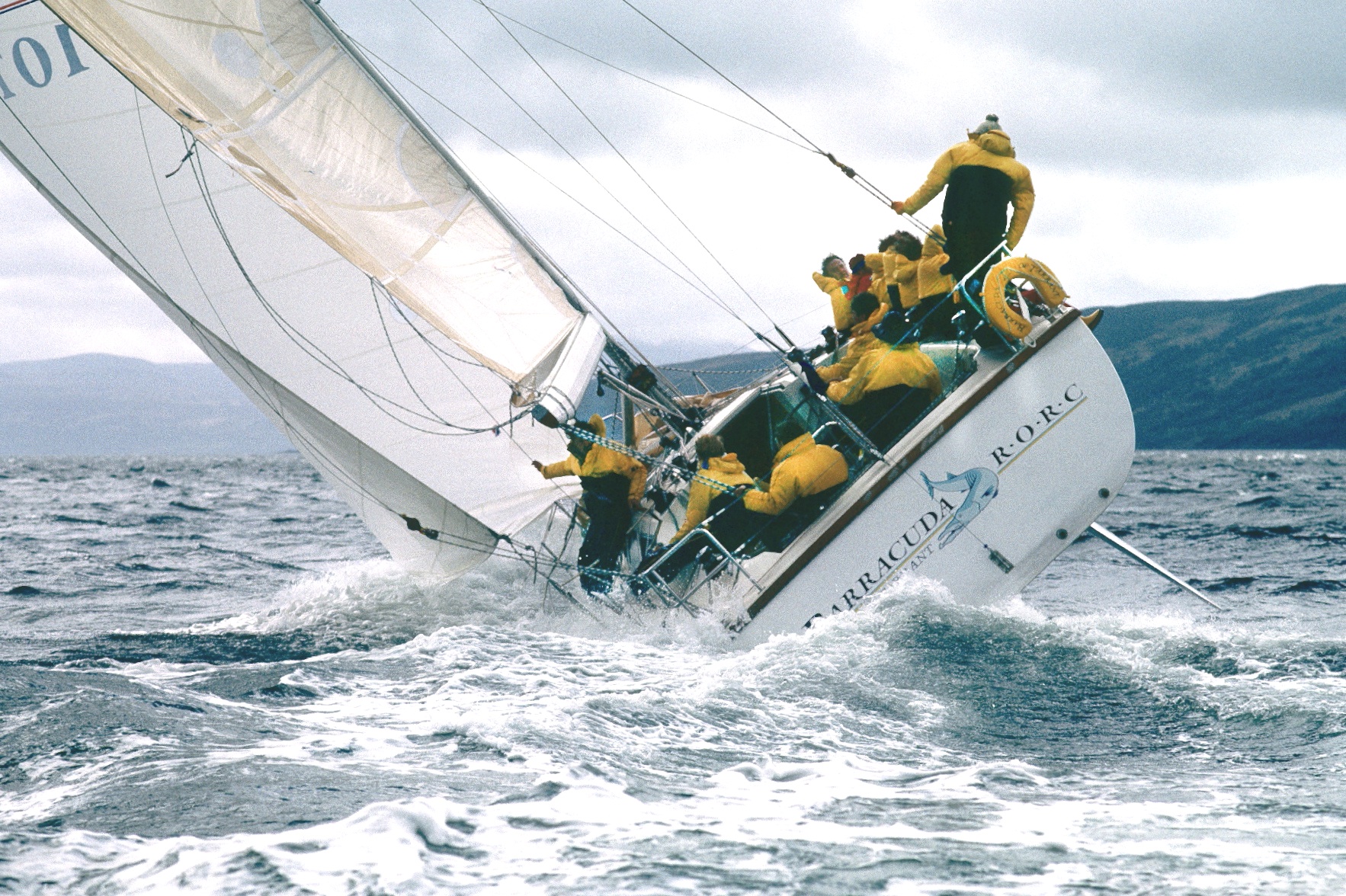
The mighty machine – Barracuda of Tarrant at the Scottish Series 1986. Twenty years before twin rudders became mainstream for large broad-sterned boats in Europe, Tony Castro incorporated them on Bob Fisher's new ULDB. In these squally conditions, a standard broad-sterned yacht of 1986 would have been spinning round to look at herself at frequent intervals. But with the skipper comfortably ensconced at the wheel under his famous black sou'wester, Barracuda tracks as though on rails, with her weather rudder completely clear of the water while her lee rudder is doing the business in a vertical position of maximum efficiency. This design of 29 years ago is still ahead of the game, and it's reckoned a boat built to the same lines and concept, but using the latest construction methods, would be one very potent machine today, Photo: www.patrickroach.com
What Has Happened to Sailors' Traditional Self–Reliance At Sea?
#safetyonthewater –Can it really be true that lifeboat call-outs in Ireland in 2013 – most of them for recreational boating of some sort - showed a staggering increase of 43% over 2012? W M Nixon discusses the disturbing figures, and considers whether it is possible to re-build the traditional amateur seafaring tradition of competence and self-reliance.
Time was when the most respected sailing folk, the people with the highest standards in their boats and in their use of them for their dedicated style of seafaring, were accustomed to sail the sea on the principle that they would much rather drown than cause any inconvenience or danger to other seafarers in any way whatsoever.
This applied particularly in the matter of being rescued. Being rescued just wasn't done. It was a sign of appallingly poor seamanship. Indeed, having what other people might describe as an adventure of any kind was frowned upon. "An adventure" was looked upon by the pioneers of cruising - just as it was looked upon by their contemporaries, the top explorers - as evidence of incompetence.
It was an admirable if impossibly idealistic attitude, which had its roots in the earliest days of amateur seafaring. In that distant era, the first very few pioneers were venturing forth for pleasure on seas where working people with much less in the way of economic resources were struggling to make a usually poor and often dangerous living as fishermen. To emphasise the difference, pleasure sailors only fluttered about the place in summer like butterflies, whereas those who worked the sea in small boats had to face its ferocity all year round.
Also sharing the sea were the crews of cargo carrying vessels whose demanding owners did not welcome tales of their vessels being delayed and the valuable cargoes put at risk, even for the shortest possible periods, in order to assist or rescue some incompetent amateur. As for the regulators of the sea, the naval ships and the revenue cutters, they were naturally suspicious of people going about their inexplicable business with "pleasure" as their reported objective, sailing hither and yon in their strange little vessels.
They undoubtedly were "little" vessels, as the new sport of cruising with its codes of a high standard was developed by the emerging middle classes of the 19th Century. Unlike the aristocracy and monarchy, who would sail the sea in large yachts with crowds of attendants and everything – including rescue if needs be - done in a very public manner as part of the grand life's rich tableau, the middle classes valued privacy above everything else.
Thus the code of self-reliance in cruising evolved, propounded by folk like Richard Turrell McMullen, who developed the principle of total self-reliance to such an extent that even in coastal waters he cruised single-handed in his final years. And even when pleasure boats numbers and rescue services had developed to an impressive level in the late 20th Century, the "shame of being rescued" was still a very potent attitude which encouraged high standards in boat maintenance and seamanship.
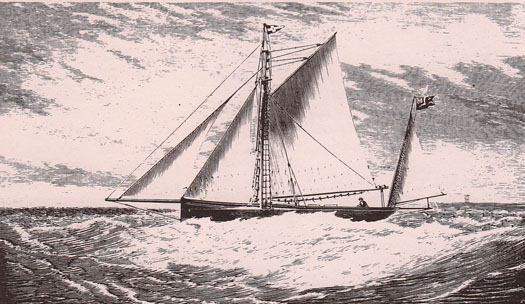
Pioneering seafarer Richard Turrell McMullen in his 42ft Orion, with which he cruised the Irish coast in 1869. McMullen expounded a doctrine of self-reliance and competence in amateur sailors, and would have regarded being assisted by the lifeboats as a matter of extreme shame.
But today, well into the second decade of the 21st Century, the RNLI call-out figures for Ireland do not make happy reading for advocates of rugged seafaring self-reliance. Could it be that the ubiquitous presence of highly-visible lifeboats in our main harbours, with their presence further publicised at major rescues, is creating excessive haste in calling them out for non-emergency reasons?
Admittedly the summer of 2013 was so good that there were many more people afloat in June, July and August than in 2012's grim conditions. Thus many of those rescued will have been casual impulse boaters, rather than dedicated seafarers. But nevertheless a year-on-year increase of 43% in lifeboat launchings, most of them for recreational boating of some sort, is very discouraging for an activity which supposedly prides itself on its capacity for sensible self-regulation, and derives satisfaction from overcoming challenging conditions without assistance.

The Dun Laoghaire lifeboat on exercise in Dalkey Sound. This was Ireland's busiest station in the summer of 2013, with 34 call-outs in June, July and August Photo: David Branigan/Dun Laoghaire RNLI
For the record, Dun Laoghaire was the busiest station with 34 call outs. Portrush in County Antrim was next on 26, just ahead of Crosshaven with 25, while Fenit, Wicklow and Skerries (where their new boat, the Atlantic 85 Louis Stimson, was named and dedicated on Saturday September 7th) were all on 17.
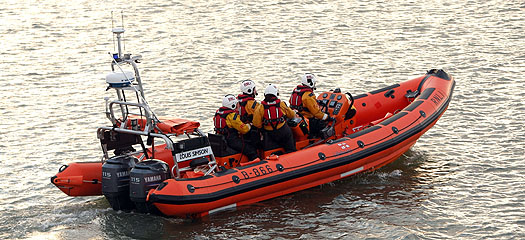
The new lifeboat at Skerries, an Atlantic 85, was dedicated and named the Louis Simson on September 7th. The Skerries station had 17 call-outs during the three summer months.
Of course there are those who will claim that, in many instances, talking of "rescues" would be over-stating the case. When a situation looks like being serious from the outset, the Coastguards – and particularly their helicopter – will get involved. In fact, so many genuinely life-saving events involve helicopters that it's surprising no-one seems to have thought of a rescue helicopter service service funded by charities. Maybe they have, but have found it would be impossibly expensive. In any case, with lifeboats, there's the obvious and stirring maritime link. "Those in peril on the sea" must be one of the most recognisable phrases known to us, and providing charity support to lifeboats is a direct and very satisfying way of connecting with it.
But the fact that the lifeboats receive so much of their funding from charity, and are manned largely by volunteers, adds to the moral overtones when any rescue is successfully carried through. And as we cannot know how even the most minor boat difficulty might go pear-shaped at some future stage, then if the lifeboat gets involved, the perception is that you've been rescued however minor the problem may have been, and notwithstanding the fact that the lifeboatmen themselves may phrase their report to spare the rescued crew's blushes.
The lifeboatmen's attitude is better safe than sorry, and much better safe even if just slightly embarrassed. But an analysis of the incidents in Irish waters is intriguing, and they provided some events with unwelcome publicity. For instance, the ISA's Gathering Cruise-in-Company from Dun Laoghaire towards Dingle in July experienced four different lifeboat call-outs.
The highest-profile incident was the rescue of the crew of 30 from the tall ship Astrid when her engine failed on the short hop from Oysterhaven to Kinsale in fairly rough conditions of onshore winds. One possible story suggests that prior to her arrival in Ireland, one of Astrid's fuel tanks had been accidentally filled with fresh water, which is something that can easily happen in a large and complex old sailing ship during a busy turnaround time in port. In line with their spirit of self-reliance, Astrid's crew had reportedly declined offers of professional assistance in making the tanks diesel-ready again. But despite their best efforts, it seems there might have still been a small quantity of fresh water left, quite enough to cause what became a catastrophic engine stoppage.
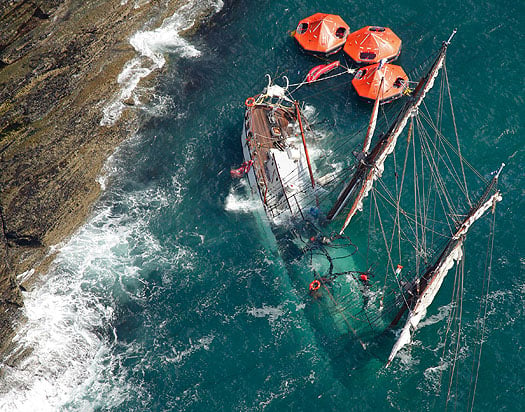
The end of a dream. The sinking of the privately-owned Dutch sail-training tall ship Astrid was a catastrophe, but it wasn't a tragedy as all 30 on board were efficiently rescued by the lifeboats. Photo: Bob Bateman
In fairness to The Gathering Cruise-in-Company, the Astrid sinking was a big ship event with which they became associated almost incidentally. But the three other call-outs were directly linked. The second most serious (after the Astrid) of the Cruise-in-Company's call outs was for the Ballycotton Lifeboat for an injured crewman on a 42ft yacht six miles southwest of the port. Injuries were such that the casualty was transferred by lifeboat to a waiting ambulance at Ballycotton, then as the injured person was a key member of the 42ft yacht's crew of three, the lifeboat returned to the cruiser and escorted her to port.
The other two lifeboat callouts for the Cruise-in-Company were to assist a yacht with her propellor fouled by a fishing pot marker off Kilmore Quay, and to tow in one of the participating boats after her engine had failed off Kinsale.
The hazard of getting fouled in fishing pot lines is even greater in Ireland than other similar places like Cornwall, where Ben Ainslie has written of his family's experience of having their fine yacht driven ashore at the entrance of the Helford River and getting badly holed on rocks, after the propellor had knotted itself in a lobster pot line. The lobsters and crabs along the Irish coast being even more prolific, it's a constant problem when under power, and there are few challenges more daunting than motoring in late afternoon straight into the sun on passage from Carnsore Point to Kilmore Quay, and knowing that the entire route is a maze of pot markers, some quite clearly defined, others lurking just below the surface in the strong tides, and all virtually invisible with the notorious brightness of the sunny southeast right in your eyes.
So for cruising in Ireland, an obvious solution is one of those cunning little cutting devices fitted to the propshaft to slice through any ropes, but even they can be defeated by too much rope. When it does happen, a serrated bread knife with the means of and quick and easy attachment it to the boathook can sometimes work wonders.
But the proliferation of cruisers with SailDrives exacerbates the problem. They may fulfil the designer's dream of having the propellor immersed as deeply as possible, and in clear water too, but it means they're perfect targets for wayward pot lines, and you need a diver or a liftout to get at them if they become fouled.
But do propellers really need to be so deeply immersed? After all, in motorboats they're close under the surface, and often reasonably accessible by long-arm methods from a dinghy. Admittedly with a sailing boat with her extra pitching through having a mast, there is a danger that a shallow-mounted propellor will come out of the water as she punches into a head sea. But for years I'd a share in the Contessa 35 with a high-mounted propellor well aft, and it never came out of the water while motoring in a head sea. Yet thanks to the boat's pintail stern - which had few other merits - you could just about reach the prop from the dinghy, whereas today's wide-sterned boats might preclude that. Whatever, in re-aligning the engine in my current boat, something which just had to be done when I discovered the builders had installed it at an angle of 21 degrees plus, when the manufacturers insist it should be no more than 15 degrees with 7 degrees is an ideal target, I now have a setup where the propellor can be reached by clambering down the stern boarding ladder.
All of which is little enough comfort for a cruising boat with a fouled propellor being rescued by the Kilmore Quay lifeboat during the Cruise-in-Company, but that in turn begs the question: Where were the other cruisers-in-company when this situation arose? The notion behind a cruise-in-company is that there's a feeling of mutual support, and minor problems can be dealt with by assistance from your fellow participants. But even in the companionability of a cruise-in-company, could it be that we've become so accustomed to hearing about the use of rescue services that even with buddy boats presumably near, an everyday get-you-home problem can still lead to an emergency call?
It seems to have happened with the lifeboat going to that engineless boat's aid off Kinsale and more recently the maritime community expressed shared embarrassment when the crew of a cruiser-racer of a notably able type called out the lifeboat when their engine failed as they sat becalmed off Wicklow Head.
But as boat numbers increase, professional privately-run services develop to meet the growing need for assistance like this. In boat-crowded places like Long Island Sound, and indeed on many parts of the coast of the USA, commercial assistance and get-you-home services have been a feature afloat for many decades. And anyone who has been around the Solent will be familiar with the SeaStart service, to which you can subscribe as a sort of insurance, and which now does commercially many of the tasks which used to take up too much of lifeboat time.
{youtube}VrqzFIfV1w4{/youtube}
Even the colours of their boats suggest that SeaStart is the same reassuring presence afloat as the AA is ashore.
Interestingly, SeaStart now sees its role as including the education of its less-experienced subscribers in order to raise their standards of boat and equipment maintenance, and improve their attitudes to sailing the sea. Yet because it's all being done by what is essentially a commercial organisation, those availing of its services don't feel themselves being morally oppressed by a do-gooder organisation or an interfering nanny state.
It works well in a densely-boat-populated area like the Solent region, but we have to face the reality that Ireland has an enormous and often rough coastline, and boat numbers are relatively very few, and often far between. So for now and the foreseeable future, most of us in day sailing, cruising and offshore racing are going to have to rely on self-regulation with a sensible attitude to seafaring, and the use of voluntary services supported by charitable donations in emergencies.
The situation is of course very different in inshore racing, where highly organised club rescue teams with their crash boats, and an admirable ethos of efficiency among their crews, set a standard of self-help and self-regulation which is a credit to our sport. But as soon as the scope of the event spreads from the purely local, and the boat-size goes beyond dinghies, we find ourselves interacting with national emergency and rescue services.
So in seeing the MOD 70 trimaran capsizing in Dublin Bay in June and observing the flurry of helicopter and lifeboat activity – all very necessary as two crew were soon in hospital, one for an extended stay with a severely fractured pelvis – we were seeing a new world. It's a situation very far removed indeed from the schooner America making her unaccompanied way across the Atlantic in 1851, with no contact with anyone until, without fuss or bother, she prepared for the historic race around the Isle of Wight which in its turn was sailed without any expectation of the use of rescue services.
And for those of us in the less exalted areas of personal choice sailing, it really is a matter of self-regulation if we are going to avoid having the authorities impose regulation upon us. In considering this disturbing 43% increase in lifeboat call-outs in 2013, it's difficult to avoid the conclusion that the only reason there aren't threatening rumbles of regulation and inspection from the government is simply because of the dire circumstances of the national finances.
Were we not in a situation of government cutbacks on every front, it's highly likely there'd already be some advisory body looking at ways of making the boating world adopt a more responsible, self-reliant and disciplined attitude towards its activities. That in turn would lead to an increased inspectorate and more supervision, with further erosion of the sense of freedom in sailing the sea. And in the end, it's boat people who would have to pay for it themselves. It's up to us to protect this activity we cherish so much, and to treat it with the respect it deserves.
ICRA's Sailing Spirit Reasserts Itself as Cruiser Racer Fortunes Improve
#icra – The Irish Cruiser Racing Association has come through challenging times recently, but Commodore Nobby Reilly sees strengthening light at the end of the tunnel. W M Nixon takes a look at ICRA and its upcoming Annual Conference in four weeks time, and somehow concludes his piece with an earthy opinion on keel and rudder design from Ted Turner.
"When you're going backwards, it's hard to stop". Difficult to see where you're going, too. The speaker is Norbert 'Nobby' Reilly, currently serving his five year watch as Commodore of the Irish Cruiser Racing Association, which will hold its Annual Conference on Saturday November 23rd in the Royal Irish YC in Dun Laoghaire. At it, the ICRA Commodore is confident the attendance will share his very strongly held belief that going backwards is now history.
In its eleven short years of remarkable existence, ICRA has embodied the highs and lows of Irish life as we zoomed up to the dizzy heights of the Celtic Tiger years, and then fell off a cliff, plunging to reality after 2008.
When the going was good.....No. Let's re-phrase that. When the going was plain crazy, Irish sailing through ICRA was in the astonishing position of putting forward three teams for the biennial international Commodore's Cup.
To outsiders, it seemed absurd that those teams appeared to be racing against each other with even more venom than they were using against the international rivals. Where was the unwritten code of the green jersey? Not surprisingly, they didn't win the Cup itself, though one team was tantalizingly close. But not to worry, surely there'd be even more new boats and fresh paper millionaires along next time, we'd do better next time round.
Chance would be a fine thing. The writing was already engraved and not merely scribbled on the economic wall when just one Irish team, carefully put together by manager Barry Rose to harbour scarce resources, did finally win the Commodore's Cup in 2010.
It was a peak of achievement for Irish sailing, and despite the fact that ICRA is just basically four people – Barry Rose of Cork, Nobby Reilly of Howth, Fintan Cairns of Dun Laoghire, and number cruncher Denis Kiely of cyberspace – this virtual organization became the Mitsubishi Motors 'Sailing Club of the Year' for 2011, and a very popular choice it was too.
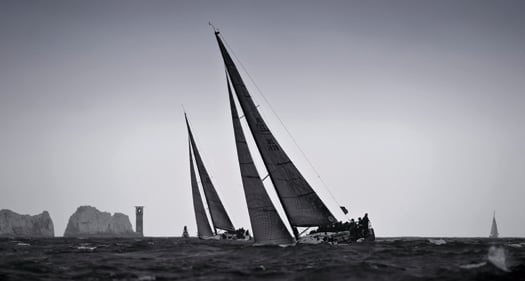
Anthony O'Leary's Ker 39 Antix from Cork was one of the team which finally won the Commodore's Cup for Ireland in 2010. Photo: Kurt Arrigo/Rolex
But by that time the ICRA people had gone back to the knitting, for they knew the prospects for sailing in general – and particularly for Ireland's international offshore racing campaigns – could well get worse before they got better. So though they lived in hope, they threw renewed energy into being the organisation which looks after the needs and hopes of handicap racers in Ireland. While simple enough to outline, it's a complex mission, and in addition to high awareness of international developments, it requires constant monitoring of the mood at grass roots level, for the strength of Irish offshore sailing is drawn from active local clubs all round the coast in addition to the inevitable focus on the big centres around Cork, Dublin and Belfast.
Thus when the blow fell and Barry Rose and his management team had to reluctantly conclude there'd be no prospect of a viable Irish team to defend the Commodore's Cup in 2012, at home the efforts were re-doubled in order to ensure that each year's annual ICRA National Championship was an event worthy of its title, and worthy of past championships. Then too, there was a determination to see that those clubs which had supported the Nationals by sending boats to other venues were in their turn rewarded by an invitation to host the Nationals themselves, with the implicit promise that this would bring fleets of top calibre to new places.
As well, there were visionary programmes to introduce newcomers to offshore racing using many different methods, including open days with the flotilla of the SailFleet J/80s. All this showed that ICRA was very much open for business. And all the time Denis Kiely was keeping the numbers up to date so that there were realistic figures available, giving ready reference for comparisons between IRC and ECHO handicap systems, for one of ICRA's strengths has been that it accommodates people who can't see their way to giving their boat the complete IRC treatment, but can afford to go the ECHO route.
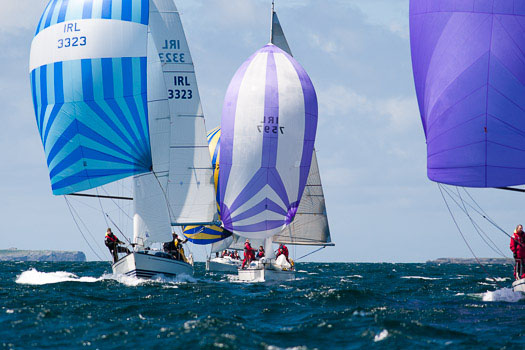
Racing at ICRA National Championship 2013 in Tralee Bay Photo: Bob Bateman
So it is that even with the constraints of Ireland's recent economic experience, ICRA has performed extremely well. Despite some unseasonal weather, the 2013 Nationals at Tralee Bay had some splendid racing, and attracted a fleet of a size and calibre rarely if ever seen beyond Mizen Head.
In addition, Irish boats have been turning in some good showings abroad in addition to the achievements by the top performers at home, and the voters for the coveted ICRA Boat of the Year 2013 award – currently held by the Galway Bay SC Reflex 38 Lynx – have a bewildering array to choose from, as boats which took the prizes at events as diverse as the ICRA Nationals at Tralee and the Sovereigns Cup at Kinsale are joined by those who had success in the Volvo Dun Laoghaire Regatta in Dublin Bay, the top performer there being Nigel Biggs' Checkmate XV which went on to win the World Half Ton Classics.
Then there was the Tralee Bay veteran boat Amazing Grace's victory in the Dun Laoghaire-Dingle Race - as somebody said, she's not called 'Amazing' for nothing – while Lynx as 'Discover Ireland' was well placed in the Fastnet and comfortably tops of all the Irish boats to win the Gull Salver, though we'll resist the temptation to point out that discovering one small but significant part of Ireland is surely what the Fastnet Race is all about.
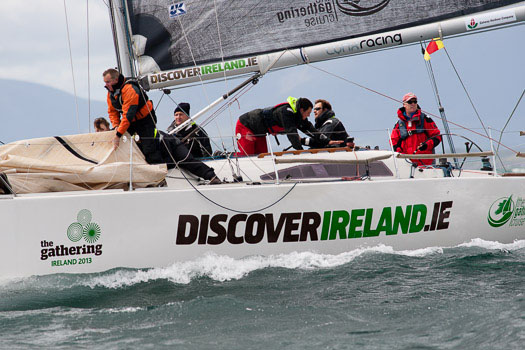
Discover Ireland took the prize in the Fastnet Race. Photo: Bob Bateman
All this is before the more recent rush of achievement, with David Kenefick of Cork with his Figaro Solo boat Full Irish winning the Rookie of the Year award, while there's been the Irish success in crewing in the Middle Sea Race, and Paul Winkelmann has brought good news from the Far East with his Class 1 victory in the China Sea Race.
On the administrative front, ICRA received an unsought but welcome boost when Mike Urwin, the head of the RORC's Measurement Office, reported that the Irish system of using ECHO and IRC handicap systems in cruiser-racer events is something which could usefully be learned from and emulated elsewhere. Maybe so, but anyone contemplating using the ECHO system should note that it works best when people race regularly and frequently, for it is a fact that in Ireland many cruisers which wouldn't be seen as racers at all elsewhere are keen to get onto the starting line, and ICRA makes sense out of what they do.
So Nobby Reilly's confident assertion that forward gear was firmly re-engaged in ICRA during 2013 is clearly borne out by even the most cursory review of the year. Looking ahead to 2014, the prospects are bright. Barry Rose already has the makings of a Commodore's Cup team with one Irish boat and an Irish-crewed American boat already signed up. With that strong foundation in place, it will be fascinating to see how the bids for the third place take shape.
As for the ICRA Nationals, it could well be the biggest yet seen, as it's scheduled for the Royal Irish YC from June 13th to 15th, which will reinforce ICRA's strong fraternal links with ISORA. For international contenders, it also offers the juicy attraction of being neatly located for the Round Ireland Race from Wicklow on Saturday June 24th, with the bonus of the Royal Irish being recognised as an official assembly point for Round Ireland Racers too large to use Wicklow Harbour for the pre-race scrutineering. And for those who'd like to spice their sailing with a spot of high culture, the day after the ICRA Nationals conclude, Monday June 16th is Bloomsday, with a special Royal Alfred YC sailing event which will honour the sailing connections in the writings of James Joyce, which is something we might just examine in detail another day.

The ICRA management team are always aware that they also have to consider the needs of keen boats and crews based far from the main sailing centres. This is the successful Dis-a-Ray on her home mooring at Tarbert in the Shannon Estuary. Photo W M Nixon
Meanwhile, though the ICRA focus will inevitably be on the east coast in 2014, the Association is well aware of its responsibilities to its fraternal organization, the West of Ireland Offshore Racing Association, which was much involved with 2013's main event in Tralee Bay. In 2014, the WIORA Championship will be at Mayo Sailing Club in Clew Bay from Wednesday 23rd to Saturday 26th July. It's a marvellous venue right on the doorstep of Westport, voted the "Best Place to Live in Ireland" in 2013. But it's so far from the main east coast centres that you're sailing for home whichever way you turn when coming out of Clew Bay. So Nobby Reilly is very keen that the ISA SailFleet J/80s should be taken to MSC's base at Rosmoney and made available for the WIORA Championships for junior crews selected and trained by yacht clubs from other coastlines, which is a brilliant notion.
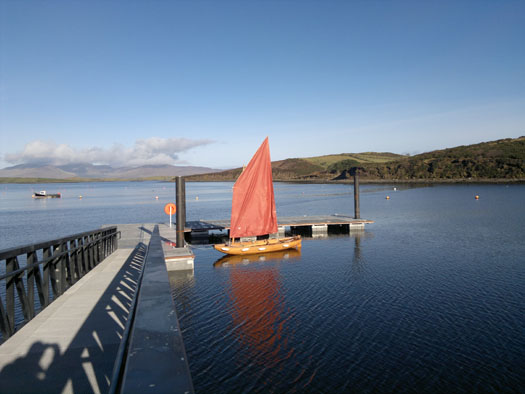
The WIORA Championship 2014 will be at the end of July 2014 at Mayo Sailing Club at Rosmoney in Clew Bay, where this new pontoon is a fine addition to facilities in a sailing area of outstanding beauty. Photo: Rory Casey
But the ICRA Annual Conference will also look beyond the needs of Irish sailing and the Commodore's Cup, as one of the main speaker attractions at the Conference on November 23rd will be Matt Sheahan. He may be the internationally-recognised Technical Editor of Yachting World, but he's one of us, as his folks cam from Dublin, and he also crewed betimes with his old mate Nobby Reilly on Comanche Raider, the big Rob Humphreys-designed offshore racer which was always one of the best-looking boats on the Irish Sea.
After the America's Cup excitement last month, it was Matt's cool on-the-spot analysis of the modifications which the Team Oracle USA people had made during the final series which most clearly brought home to readers just how tiny the game-changing mods could be, yet they helped the Americans come from far behind to retain the trophy.
A particular area of development was the fitting of tiny bulbs to the big catamaran's foils to reduce drag. We are all well aware that the fitting of bulbs under the bows of big ships must be worthwhile, as ship-owners – a notably parsimonious breed – will lash out on such things, confident that they make their vessels more easily driven and therefore more economical. Yet anyone who is accustomed to watching ship and boat hulls move through a seaway will guess that bulbs are at their most effective when there is minimal pitching, as a bulb going up and down, rather than just smoothly forward, will generate a whole new dimension of turbulence.
But the bigger the ship, the less the pitching, and the greater the benefit. When we remember that the America's Cup 72ft catamarans were sailing in what was for them smooth water, the fact that their hulls were not pitching, but rising relatively slowly on the foils, could be accommodated by the bulbs with a level of turbulence which was acceptable in view of the performance benefits shown a few second later. And once the benefit had been shown, the crucial thing then became just how far forward the bulb should be located relative to the foil – it seems an inch or so made a significant difference.
On ships, some bulbs are now remarkably long, with the total underbody being shaped to be as economical as possible in the prevailing conditions in which the ship will be functioning. What will work best averaged over a long period in narrow waters such as the North or English Channels may not necessarily work as well in open ocean, or indeed on wider waterways such as the Irish Sea or St George's Channel, but the Baltic area seems to create ships which work well in our channels.
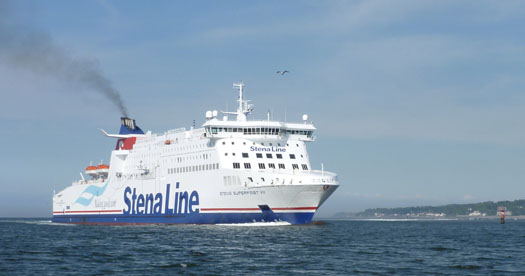
The extra large bulb under the bow of the Stena Superfast VII begins to become more evident as she slows down approaching Belfast. Note her quarter wave on the port side creating surf on the Holywood Bank. Photo; W M Nixon
We were making our way into Belfast early in the summer and one of the 30,000-ton Stena Superfast vessels coming in from Scotland overtook us. In open water, she'd been travelling from Cairnryan in Loch Ryan at 27 knots – which is cooking with gas – but even with a lot of slowing down approaching the head of the lough, she was a big waterborne presence, and we noted her wake breaking spectacularly on the Holywood Bank on her port quarter close astern.
But even more notable as she drew abeam was the bulb, at first immersed under an almost sinister little hill of water, but then revealed with its own bow-wave as the Stena Superfast VII slowed even further. The bulb seemed to be the size of a mini-submarine.
The ships of this marque were originally built for Baltic crossings in 2001 or thereabouts. Stena chartered two of them longterm two years ago, gave them a massive refit with new livery, and put them on the route serving their new £80 million terminal at Cairnryan. With a crossing time of just 2 hours and 15 minutes without the hassle of getting yourself all the way down to Larne for the shorter sea route, it looks as if big bulbs do the business.

The bulb is the size of a mini-submarine, yet it helps the Stena Superfast VII to travel economically at a very competitive 27 knots on the Belfast-Cairnryan route. Photo: W M Nixon
But as with anything to do with the sea, it all has to be a total package. With bulbs as with boat hulls, you have to think tadpole. A tadpole has a bullet head with a long tail which may primarily provide motive power, yet it takes very little effort to move a tadpole quickly and easily through the water. If it didn't, frogs would have long since become extinct. But it's a relatively straightforward business parting the waters, it's how they close in behind that decides whether tadpoles or boats or bulbs are easily driven.
Down in West Cork, one of our agents (who had better be anonymous this time round) came upon this hull modification near the banks of the Ilen River. Somebody in Skibbereen had clearly taken on board the value of bulbs on the bow, but hadn't quite seen the notion through to complete fulfillment of all requirements.
At first it seems a clever use of Camping Gaz containers, but closer examinaton reveals it is Blugas. Maybe it's only Blugas bottles can be utilized in this way, or maybe it was a cunning advertising ploy to publicise the lesser-known product. Whatever, it looks as though a clever idea hasn't been completely thought through – this Blugas bow bulb needs a tail. And lest you think that we're trying to get this Ilen innovator into fresh expense, Afloat.ie's R & D department reckons just one traffic cone and the cunning use of epoxy, with the new tail filled with builder's foam, is all that is needed.
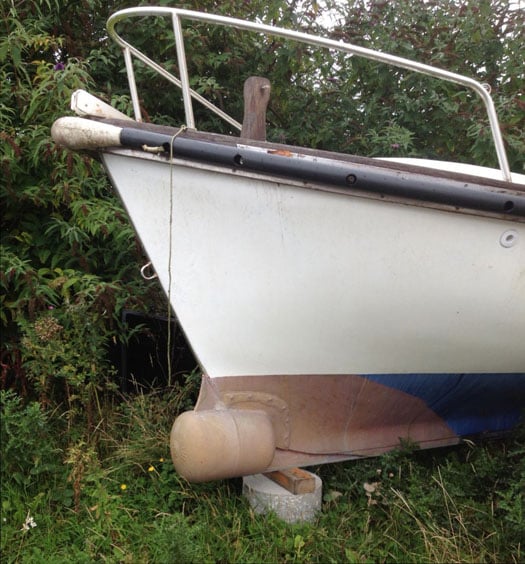
Lateral thinking, West Cork style. Former gas cylinders have been pressed into use to create a bow bulb........
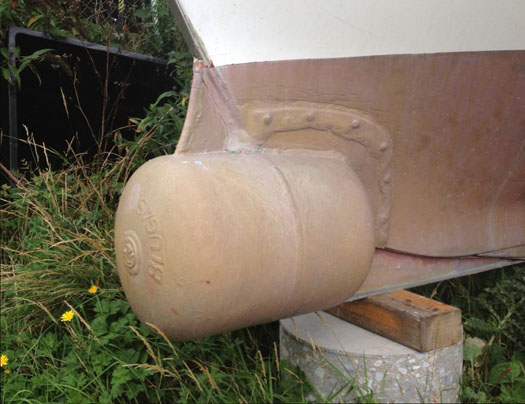
....but we'd suggest the additional use, at the aft end, of a modified traffic cone might produce an even more effective shape.
The final word on the need for a tadpole tail was delivered by the great Ted Turner many years ago, when he was called upon to see if he could get some sort of improved performance out of a new 12 Metre, an America's Cup potential defender designed by the late Britton Chance. In his plans, the perenially innovative designer had replaced the usual sharp trailing edges of keel and rudder with quite wide flat surfaces. He claimed that if these cut-off endings were of the right width, a width which he'd calculated himself down the zillionth degree, then the keel and rudder would create a vortex on their flat trailing surfaces such that the sea would be beguiled into thinking that they actually finished quite a few inches further aft, and finishing moreover in a sharp trailing edge in keeping with accepted practice. With the reduction in wetted surface brought by the cut-off look, light air performance would also be greatly enhanced.
Well, it wasn't, and nor was performance in airs of any kind. You can't fool the sea. So after giving it his best shot, Turner asked if he could see the boat out of the water, as his inability to resist a challenge had meant he'd taken it on sight unseen. So there was the boat still dripping, and the flat back ends all too obvious as Professor Chance launched into a spiel about how it all worked perfectly in theory, and so there must be some other reason for the boat's poor performance.
Turner let him have his say, then demolished the theory. "Britty" said he in his best good old boy style, "Britty, even a standard piece of floating faeces finishes in a point".
Except that the great man didn't use the cumbersome term "standard piece of floating faeces". He used a rough four letter word beginning with 'T'. But this website having a family readership, and it the Bank Holiday weekend too, we won't use the T-word this time round. Have a good weekend.
America's Cup. From Isle of Wight to Hamilton Island
#americascup – If the 36th America's Cup is staged at Hamilton Island, it will continue a long story, started from the Isle of Wight in 1851. W M Nixon introduces this exotic venue, then ponders the ultimate seaworthiness of multihulls.
We signed off here on this sailing blog a fortnight ago with the admission that the sacredly monstrous America's Cup in its new form for the 34th Edition has got us hooked, as indicated by our own and general global interest in that key question: "What happens next?" That was Saturday September 28th. We didn't have long to wait. On Monday September 30th, it was announced that Hamilton Island Yacht Club of Australia has been accepted by cup holders Golden Gate Yacht Club as the Challenger of Record for the 35th America's Cup.
Hamilton what? Where island? Is it somewhere comparable to the Isle of Wight, where it all started way back in 1851 with the race round the island for the Hundred Guineas Cup? For once, we were ahead of the posse without having to go to google. Back in 2007, Gordon Maguire was signed up as lead helmsman on Mike Slade's 100ft Leopard for a serious tilt at the Fastnet Race record. But that was the year that the start was postponed for 25 hours because of a Force 9 sou'wester. And Maguire's window of opportunity to do the Fastnet was very narrow, as he was contracted to be at some event called Hamilton Island Race Week to skipper Matt Allen's Ichi Ban immediately afterwards.
He took a look at the new schedules, and reckoned the Fastnet start delay ruled him out, and flew out for Australia. But Leopard still broke the record. Yet all we can really remember about it now is it was the year Ger O'Rourke's Chieftain was Fastnet Race overall winner, and that this Hamilton Island place with its race week must have something very special going for it.
Five years down the line, it's more special than ever. Hamilton Island is owned by veteran campaigner Bob Oatley, a serial entrepreneur whose sailing credentials have been firmly established with a long string of boats called Wild Oats, with his current hundred footer Wild Oats XI holding the Sydney-Hobart Race record. Hamilton Island resort is one of his pet projects. For some of us, the fact that the daytime temperature seldom goes below 26 degrees is a distinct drawback, but others will think it paradise. It's among the Whitsunday Islands on the Great Barrier Reef coast of Queensland, and the Australian distances are enormous – you're talking about a dozen hours of steady driving north from Brisbane.
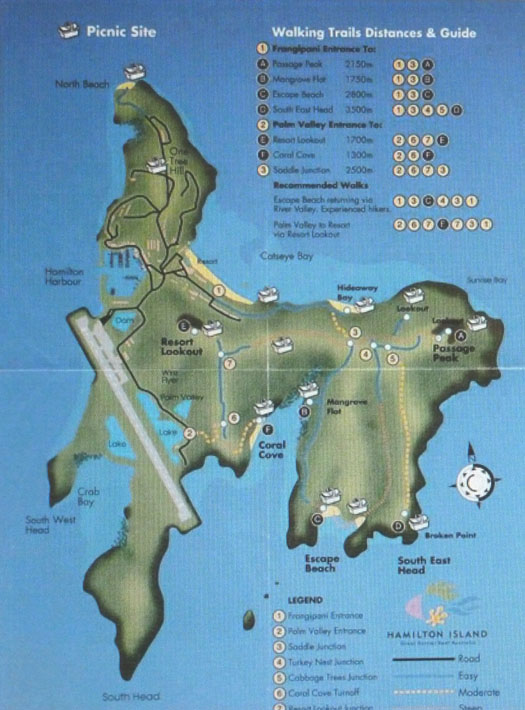
Every America's Cup location should have at least one picnic site. Hamilton Island has all the facilities for the big one
Thus everybody hopes to fly there, as it has its own airport where the runway comes in one side of the island, and goes out the other. It's right beside the harbour, thus it's possible to get sailing immediately to avoid having the temperature floor you. And if you're minded to sail round the island to celebrate getting there, it shouldn't take too long, as Hamilton Island is just three miles long by two miles wide, though it's so indented with bays that it's only two square miles in all, about twice the size of Lambay.
That said, as it's among the coral of the Great Barrier Reef, not all the sailing around Hamilton Island is as straightforward as getting round Lambay. For even if you avoid Plum Pudding Reef and Fitzalan Reef and Hamilton Island Reef itself, and then keep clear of Perseverance Reef and Young Island Reef, there's still Surprise Rock Reef waiting to...well, surprise you.
But the word is the yacht club is very fully appointed, and just itching to host the America's Cup eight years down the line. However, what form the America's Cup will be eight years hence is anyone's guess, and currently it's open season in the global comment and criticism stakes, with advocates of multi-hulls in a defiant "We told you so" frame of mind as the world of sailing grudgingly admits that the 72ft foiling catamarans in the 34th America's Cup brought the thing to life.
Instinctive multi-hull resistance is nothing new. The Polynesians and other Pacific islanders may have been merrily trundling around their nice warm ocean for centuries on multihulls of all types, but attempts to transfer the concept to colder waters failed to do the business for many years. Way back in 1663, that extraordinary polymath William Petty, the man who created the Down Survey which tabulated Ireland, tested his own-designed catamaran Simon & Jude (which he'd had built in Dublin) in the Liffey and on Dublin Bay, and the new machine out-sailed a ship's gig and a "pleasure boatte" of renowned performance. The Simon & Jude was re-created for Hal Sisk by master shipwright John O'Reilly in Dublin in 1991, and a race was staged with one of the Bantry Boats and a little Dutch cutter enthusiastically playing the roles of the opposition, but the S & J outsailed them both.
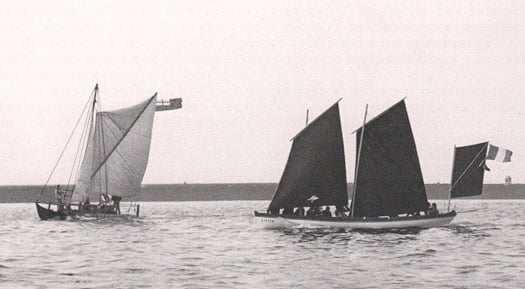
Ireland's first multi-hull, the Simon & Jude of 1663, was re-created by Hal Sisk in 1991 to re-stage her initial race when she comfortably outsailed a ship's gig, re-enacted here by one of the Bantry boats. Photo: W M Nixon
However, the concept soon came up against the ultimate seaworthiness trial after Petty built The Experiment, a much larger catamaran with accommodation. She certainly outsailed the Dublin-Holyhead packet boat by a significant amount, but failed to return from a test venture into the Bay of Biscay, and the old salts happily stuck with their traditional mono-hull craft.
In subsequent centuries the idea arose again from time to time, and in 1870 a Belfast amateur sailor, John MacKenzie, created the 21ft Jumelle, with a twin hulls of sufficiently modern appearance to make the classic 1870s gaff cutter rig fitted to her seem bizarre. By all accounts she could sail well in a straight line – speeds of ten knots were reported – but despite it being a time when yachting was developing rapidly, the people spending the money were notably conservative, and the Belfast Lough yachting establishment stayed determinedly with their mono-hulled cutters, schooners, ketches and yawls.
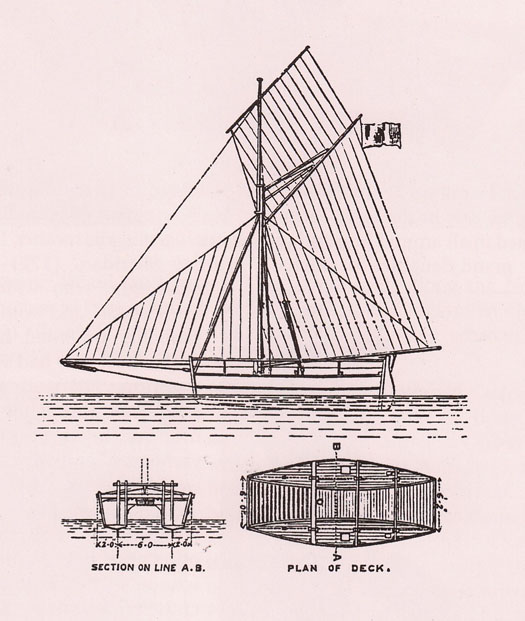
John MacKenzie of Belfast designed and built the 21ft catamaran Jumelle in 1870, and achieved speeds of 10 knots.
This conservatism was also found in America. When the 28-year-old designer Nathanael Herreshoff turned up with his new catamaran Amaryllis for the American Centennial Regatta at Staten Island in 1876 and won in very convincing style, catamarans were promptly banned from all future events. But in truth it was only with the development of lighter building methods and more advanced engineering that multihulls could really show their full potential, and it wasn't until the 1960s with innovators such as the late great Dick Newick that serious offshore racing multihulls finally began to gain traction.
Let's face it, we'd all love multihulls and would happily tear about the seas with them, if two very fundamental problems could be solved. Firstly, how do you find a berth for them when they're twice the area of monohulls of similar size, and sometimes aren't the best at manoeuvring in confined space. And secondly, how can you get round the fact that they are even more stable upside down than they are right way up, and are completely lacking in the mono-hull's self-righting ability?
Putting these problems aside for the moment, there are some very attractive cruising multihulls, and for some time – particularly before I got hip and knee replacements when boats heeling over used to be a pain – I fancied, and still do, the Dragonfly range built in Denmark. We've something of an inside track on the Dragonfly 920 as two of the Howth diaspora, Johnny Malcolm and Black Bob Fannin, crew with Roland Sharp who has his Dragonfly 920 Ischnura based in the Thames Estuary, and they have now and again speeded round to Cowes to do the Round the Island Race with quite a modicum of success.

The Danish-built trimaran Dragonfly 920 is one of Europe's most successful multihull performance cruisers
In 2011 they won the multihull division, and last year they came second. That race of 2012 was memorable, as Ben Ainslie was helming the mighty Eleanor, the re-creation of the legendary Westward, the 135ft Herreshoff schooner of 1910 vintage. This awesome vessel started in the early morning before the multihulls, slugging westward down the Solent in majestic style, but the cheeky little Ischnura was past her before the Needles despite breaking a jib sheet which cost her the win in her class, but she still was a good second.
This gives a hint of the Dragonfly's performance potential. She was hitting 15 to 20 knots comfortably round the back of the island, and having started at 0600, they'd finished the 50-mile circuit course by 1130. Ischnura is the version known as the Dragonfly 920 EX (which is Extreme if you really want to know), but though she's optimised for performance with extra sail area, she still has the advantage of being based around a single central hull which can be utilised to provide much better accommodation than a catamaran of the same 30ft size, for it's said that you need to go to 40ft or even 50ft before you can start putting decent accommodation in a catamaran.
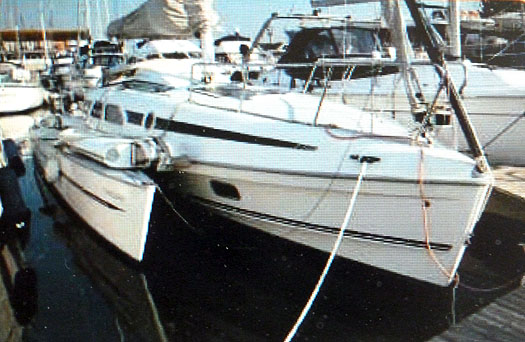
Berthing problems solved. The Dragonfly can fold her wings.
Thanks to swing wings, the Dragonfly range can halve their beam to come into a marina berth. The builders claim it can all be done from the cockpit taking a minute for each side, which is probably rather faster than the raising of the bowsprit by a gaffer in order to reduce overall length for berthing purposes. So with beam reduced and a light overall weight, the Dragonfly is also a proposition for easy trailing. In all, an attractive package, but building light and strong is expensive, as is providing the engineering for the swing wings, so it has to be faced that an almost-new Dragonfly 920EX sold recently for €142,000, which you can compare at your leisure with boats of similar accommodation, and reach your own conclusions.
But putting the price aside, and having dealt with the berthing problem, what's the situation regarding scary sailing? This week's vid of Jeanne-Pierre Dick's MOD 70 capsizing is a reminder of the ultimate vulnerability of multihulls, but in sailing Ischnura in a wide variety of situations, Johnny Malcolm says he has never felt cause for alarm, while the enjoyment factor as she ramps up the speed is fantastic. But he did mention that he wasn't aboard when Roland Sharp and Black Bob Fannin were tearing past the North Foreland in wind over tide and carrying the spinnaker in rather more wind than they should, and they did have a megafright, but lived to tell the tale.
But following the capsize of a Dragonfly 28 in the Round the Island race, the boat's enthusiasts – and they are many – simply stated that it's a fact of life: if you drive any trimaran too hard, you're going to capsize. However, it's when multi-hulls are sitting becalmed and get hit by a sudden gust that their ultimately non-self-righting characteristics can become unexpectedly evident. In the more mountainous parts of Scotland's West Coast, where the hills are high but the waters narrow, multihulls have had their problems. One of the most squally places is Loch Scathvaig, which thrusts deep into the Cuilins of Skye. A Dragonfly 28 sitting totally becalmed here was reported pitch-poled by a katabatic blast, and the water being deep, went completely upside down.
You don't need to be right under the heights of the Cuilins in order to experience sudden gusts of real power. Just round the corner and up the southeast coast of Skye along the Sound of Sleat is Isle Ornsay, a lovely spot whose only disadvantage is that when the wind is from the east, it can come storming across the Sound big time out of the brooding mountains of Loch Hourn, and sudden easterly squalls seemingly out of nowhere are another Hourn treat.
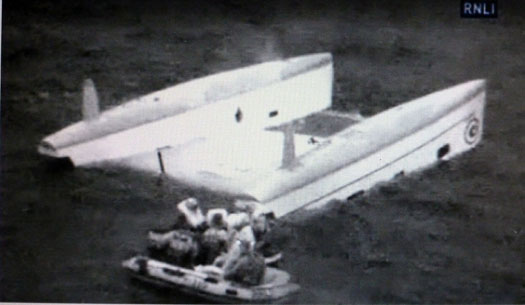
Horrid end to a lovely day.....the new Pampero TS52 is flippd by a sudden squall in the Sound of Sleat, 1st August 2012
In 2012, a big new French cruising catamaran, a 52ft Pampero TS, was sitting flat becalmed off Isle Ornsay. The name of the marque proved an unfortunate choice. A Loch Hourn pampero squall arrived with a bang. Before she could get moving to improve sail carrying power, and before anyone could get to the mainsheet, she was upside down.
Everyone was taken off safely, and within days an ace Isle Ornsay team led by Pete Fowler had righted her and brought her into Mallaig. We happened to call by that fine port a few days later on our way back from the Outer Hebrides, and as our skipper Dickie Gomes used to be a multhull ace with the 40ft Northern Ireland-built Newick trimaran Downtown Flyer (we'll return to that story another day), we were interested to hear his views on the big salvaged boat in the quayside yard.
My word, she was big. Enormous. The mast alone was like a round tower or a minaret. And with everything on the boat and about her, there was a feeling of the suddenness of it all, the total upset to a pleasant day. We came upon two or three salt-stained playing cards scattered in the cockpit. The vision of a sophisticated French charter party leisurely playing cards with highly intellectual conversation and then – zap – came irresistibly to mind. The imagination was enough. Even our skipper, seldom at a loss for words, had little to say.
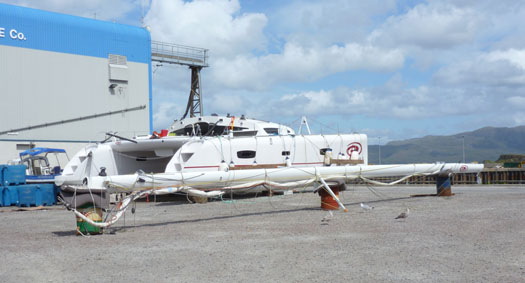
At first glance the salvaged catamaran in Mallaig seemed to show few signs of her capsize.......Photo: W M Nixon
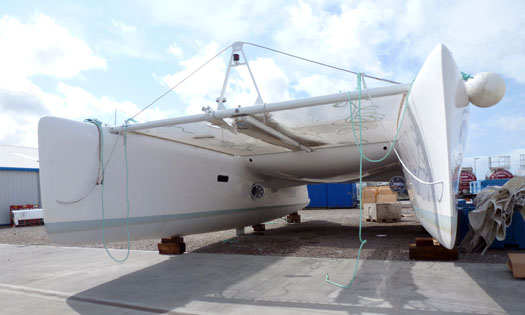
...and gave all the impressions of being a powerful fast cruiser....Photo: W M Nixon

....but soon the evidence could be discerned....Photo: W M Nixon
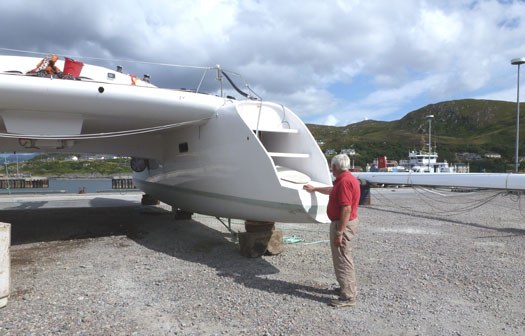
...and then everywhere we found signs of sudden catastrophe. Photo: W M Nixon
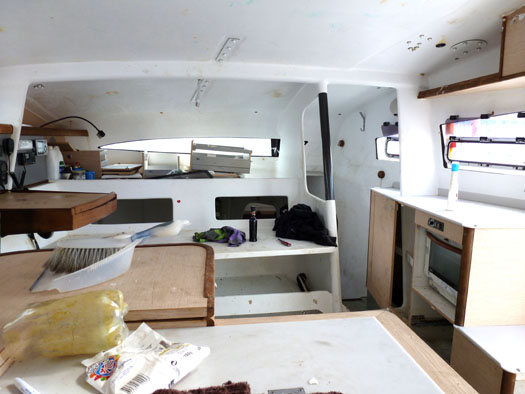
It was clear how spacious and stylish the big saloon had been....Photo: W M Nixon
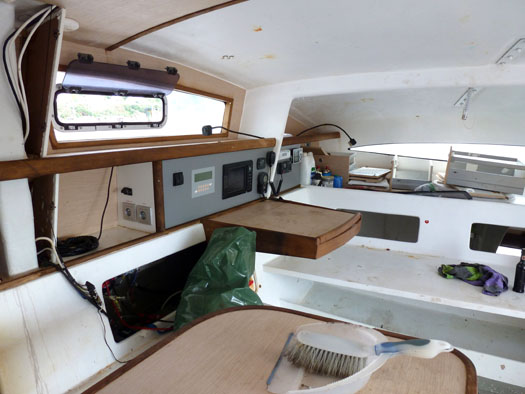
.....with its stylishly planned layout now damaged by oil and water Photo: W M Nixon

Our skipper, formerly a very determined offshore multihull racer, was for once lost for words. Photo: W M Nixon
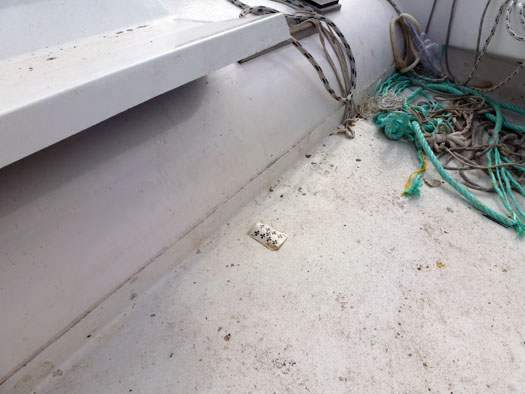
It was easy to imagine how peaceful things had been before the squall struck. The charter party may even have been playing a game of cards in the cockpit......Photo: W M Nixon
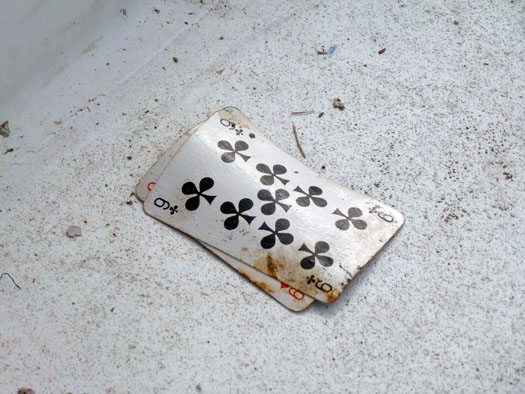
A pity. It had the makings of a good hand. Photo: W M Nixon
So even the big expensive multihulls have this ultimate drawback. There's no way around it, offshore multihulls should carry a health warning. But the rewards of living with the risk are fantastic sailing, and an ability to eat up the miles on passage in a style which leaves much larger craft in the ha'penny place.
The fact that it's decidedly different from orthodox sailing is all part of the package in making the America's Cup excitingly exotic. It needs multi-hulls, and it needs a bit of size. They talk of making them more affordable in order to attract more teams o the next series. But "more affordable" suggests smaller. Surely they couldn't be think of going below 60ft? And no doubt when the bubbles have settled a bit, some bright spark will say that the only way to maintain the excitement is to make the next generation 90ft.
Whatever, it's a long way over 162 years from the Isle of Wight to Hamilton Island. And it's a long way from he robust ocean-crossing schooner America to the extraordinary machines that captured global imagination in September. What happens next?
Boatyard Bliss, Where Owners Can Work On Their Craft
#boatyards – The interface between sea and land is infinite in its variety, and attractive to modern man as somewhere interesting to live. So if you set up a little coastal boatyard almost anywhere, very soon you'll be told that the property would be much more valuable if it was re-developed for residential use. Thus in Dublin, while we're more than happy to go along with the ancient north-south Liffey divide (Vikings to the north, Normans to the south, and the Irish somewhere out in Kildare), the reality is that in terms of property values, the divide is east-west, though admittedly with added north-south undertones.
This is fine and dandy for real estate theorists and the happy owners of desirable property near the coast. But with layup time and winterising schedules upon us, it makes life increasingly difficult for the dwindling band of boat owners who try to do their own boat maintenance and modification, and may even have built their boat from scratch in the first place, or at least from a bare hull.
Such people – and I'm one of them – operate in a different world. We amateurs working on boats, we barely qualify as a genuine economic activity. Our wives (very few of whom get directly involved) quite rightly dismiss it all as foostering. As for the rest of the community, we amateur bodgers are an embarrassment. We're out of sync with the new reality. These days, we live in an increasingly specialised society, where the preferred location for boat-building is in a purpose-built factory many miles inland where the land is cheaper, while waterfront servicing and repairs are swiftly executed in state-of-the-art units, where throughput has to be rapid and efficient.
Delays are anathema to people running these successful waterfront businesses. But delays and leisurely contemplation are essential for the DIY boat bodger, as he may eventually think of a much better way of coping with a problem which would have been dismissed as intractable by the professional, whose solution would have been the complete replacement of the troublesome item, and probably the complete replacement of the entire boat, all done before close of business that day.
The boat bodger doesn't think in terms of days, let alone close of business. All he needs is all the time in the world, and his own little space. In most modern coastal communities, neither is available. So we wax nostalgic about traditional yards where the boats came up a slip (at least a day's work in itself), and the work schedule stretched gently into the infinite beyond.
Every so often we still come across such places, and if we're on other business in the area, I am expressly forbidden from going near these paradises for boat nuts, as they're very heaven, and I'd be lost for the rest of the day But you won't find any in Dublin, where boat life now is all travel hoists and cranes and strictly scheduled throughput, while people think a slip is something that happens on a banana skin. However, if you get way from the big urban centres, there's more chance of finding yards which somehow retain enough of the traditional mood to relax the stressed boat owner, while at the same time embracing enough of the present to stay in business. And they're filled with boats which are themselves a living history of yacht design.
Perhaps the most remarkable boatyard place in Ireland is around Oldcourt in West Cork, where the Ilen River comes conveniently near the road as it meanders on its way down from Skibbereen to Baltimore. Several marine-related businesses seem to overlap here, there are boats of all shapes and sizes, and there are certainly some craft for which this is the final port of call. But as Spring arrives, somehow the numbers ashore get less, the number of emptied cradles increases, and despite the unhurried atmosphere, a lot gets done.
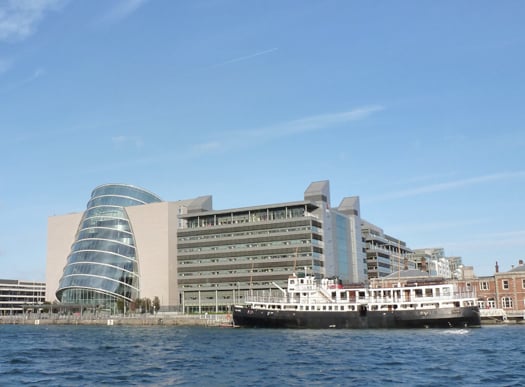
Oldcourt achievement. The Cill Airne restaurant ship in Dublin was successfully converted for her new function at Oldcourt on the River Ilen in West Cork. Photo: W M Nixon
A remarkable Oldcourt achievement was the conversion of the Cill Airne, the restaurant ship now berthed in the heart of Dublin. Originally, she was Cork Harbour's tender to take passengers out from Cobh to great liners, and then she was a training ship for the marine academy. Her active seagoing career finished, she still had plenty of life in her for a new existence as a restaurant boat, but a conversion job in an orthodox dockyard would have been prohibitively expensive. Somehow they managed to get her up the river and alongside at Oldcourt, and once there, were able to take their time for a very fine job. In all, 132 different tradesmen, recruited mostly in West Cork, worked on the Cill Airne in the Ilen River. This past summer, when she was the focal point for the Riverfest during the Old Gaffers Golden Jubilee visit to Dublin, the boat-bodging gaffers were completely charmed to learn that this fine conversion had been done at an old-fashioned boatyard, just like the kind of place they dream of locating their own boats, if only they could find it in their area.
The heart and soul of Oldcourt, the warm spirit of the place, is embodied by the continuing restoration of the Ilen, the Conor O'Brien ketch which Gary MacMahon brought home from the Falklands quite a few years ago now. Her gentle restoration is an end in itself, and a balm for the soul. Love of wood is inherent in most of us, as an affinity for wood and an instinct to do something useful with it was a key survival mechanism at an important stage of human evolution. So it is still part of our makeup, and the Ilen restoration shed is a place of healing and mental comfort.
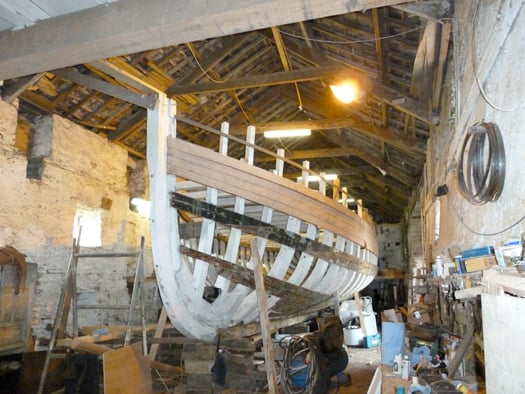
Sweet work. The restoration of Ilen has been a reassuring feature of life in Oldcourt for some time. Photo: W M Nixon

An early stage of the Ilen's restoration. Photo: W M Nixon
Up in the northeast of Ireland, hidden away behind the islands along the west side of Strangford Lough, is Billy Smyth's boatyard at Whiterock. If you were a film producer and requested your location scouts to find the classic traditional small boatyard to make a movie about sailing in times past, they would become ecstatic about Billy Smyth's. It's very basic yet remarkably efficient, while the quality of the work done by Kenny Smyth and his team is first class. And inevitably, there's the usual small quota of boats whose owners don't seem to want them launched now and again, and some from one year to the next. For some time, I'd been trying to trace a John B Kearney-designed 1936-built 6-ton yawl, the Rosalind, which had last been reported in the Poole area in the south of England many years ago. She'd gone under the radar, but she turned up this past summer in Billy Smyth's, where she has been under a cover for years in a corner of the yard, her owner's intention unfathomable.

Just another boat under a cover in the corner of a boatyard...Photo: W M Nixon

....but as the cover was hauled back......Photo: W M Nixon
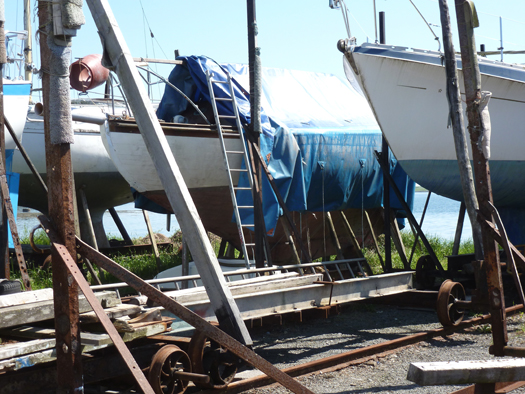
.....the 1936 John B Kearney 6-tonner Rosalind was revealed. Photo: W M Nixon
You may well think that it's only in Ireland that you can still find these gems of living boatyard history, but in the summer we were at the head of the Helford River in Cornwall, and found ourselves in the midst of the easygoing maritime mayhem which is Gweek.
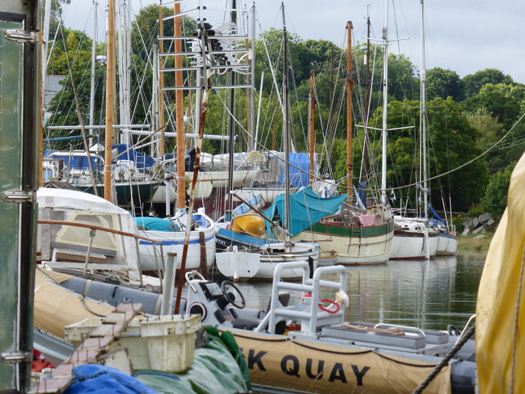
At the head of the Helford River estuary in Cornwall, Gweek Quay is a place of promise and fascination. Photo W M Nixon.

Gweek is renowned as the birthplace of several Luke Powell pilot cutters. This is the Agnes, built in 2002 and based on a Scillonian pilot cutter of 1841. Photo: W M Nixon
In recent years, Gweek has been best known as the place where Luke Powell built his renowned Pilot Cutters, whose lines are unchanged from the mid-19th Century. But there's much more to Gweek than that. If your perception of England is of an over-regulated place where nothing much can happen without some peak-capped official's say-so, Gweek is an eye opener. Basically it's a creekhead boatyard, where the yard is filled with an astonishing variety of craft, many of them character boats, and some of which haven't been launched for a very long time.

Serious work. GRP gigs emerge from the moulding shop at Gweek. Photo: W M Nixon
There's an unmistakable air of amiable anarchy, yet with underlying purpose. Some sheds were busy while we were there, finishing GRP double-ended gigs. Nearby was a large pop-up tent of a boatshed, and a looksee inside revealed it held the famous classic offshore yawl Lutine, restored recently at Gweek and taking a season off from seafaring. And all around another part of the creek, there were the houseboats.
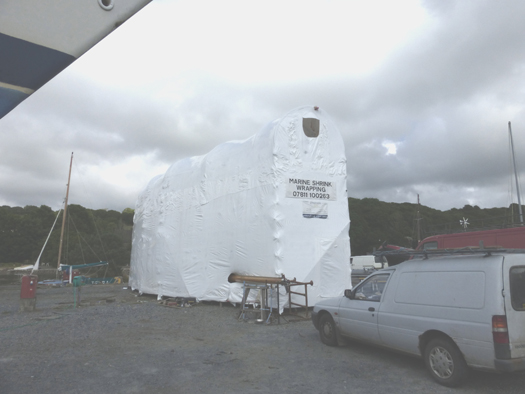
A pop-up boatshed invited a look inside.....Photo: W M Nixon
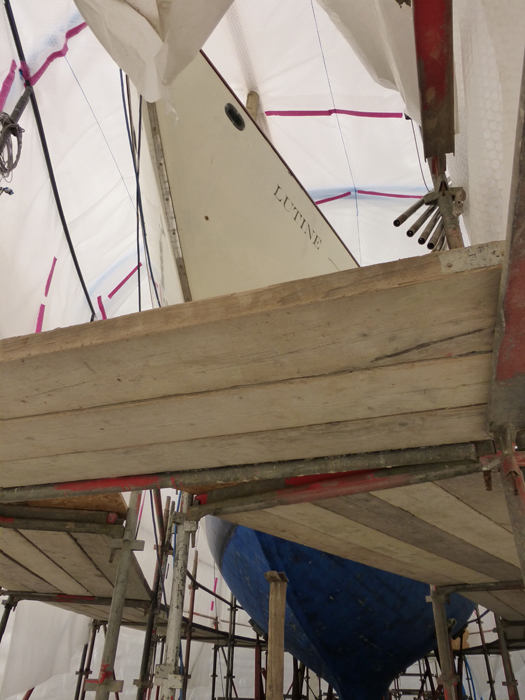
...and we weren't disappointed. It was the classic offshore racing yawl Lutine. Photo: W M Nixon
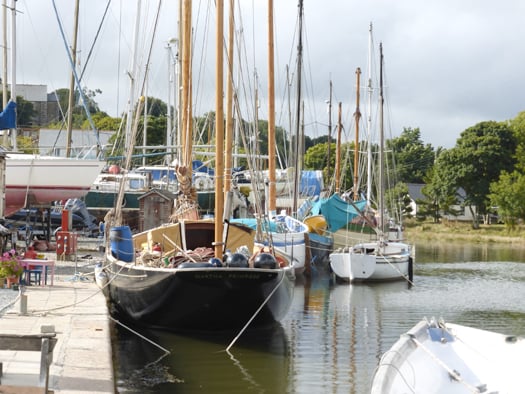
At Gweek, classic yachts share space with more humble craft....Photo: W M Nixon

....and the owners are determined to have domestic comfort while in port. Photo: W M Nixon
Clearly, the houseboats, both in their location and appearance, are subject to no planning requirements whatever. Ancient hulls had their upperworks extended in stratospheric style. What looked like a former River Thames lighter in beside the trees had a three storey structure atop it like a Missisippi riverboat. And yet they weren't the last resort of people desperate for somewhere to live. Judging by the cars parked about the place, living in houseboats – however odd - was a lifestyle choice made by people who could well afford to live ashore.

The houseboats in Gweek are a study in themselves. Note the "office & facilities block" on right, complete with public phone Photo: W M Nixon

With no apparent planning restrictions, the Gweek houseboats can go for height........Photo: W M Nixon
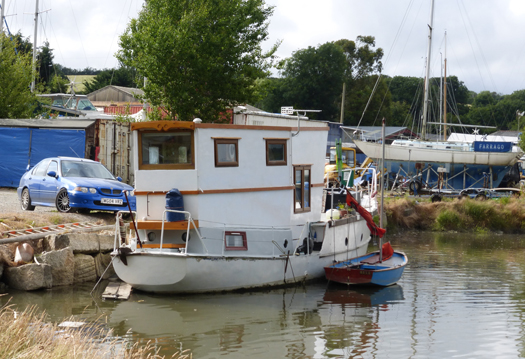
....even on boats where you wouldn't expect it. Photo: W M Nixon
So it's all of a piece that for some glorious years, the yard in Gweek was where Luke Powell built his cutters. They're arguably of an even older design type than the Galway Hookers, yet like the Connemara boats, they attract a passionate following, people who would sail on no other boats, and in a contemporary anchorage, a Powell cutter will certainly stand out, a glorious blast from the past.
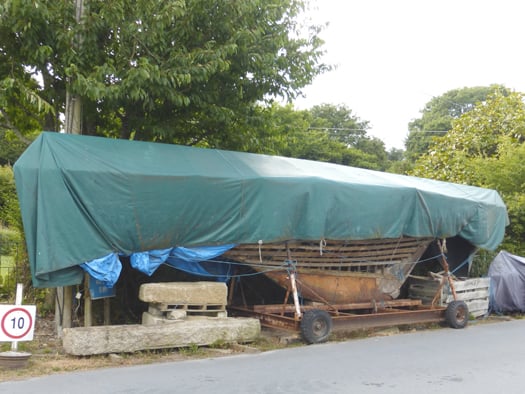
Not all Gweek projects are showing signs of progress. This may have been an International 6 Metre once upon a time, but she needs a lot of attention. Photo: W M Nixon
Blasts from the past were the theme of another boatyard visit, this time to Gloucester where the Severn winds its way between the Malvern and Cotswold hills. If you follow the doings of the tall ships, you'll know that T. Nielsen & Co's yard at Gloucester is the place to get sailing ship problems put right, and the yard in the midst of the historic docks in Gloucester has deservedly acquired a high reputation for serious work.
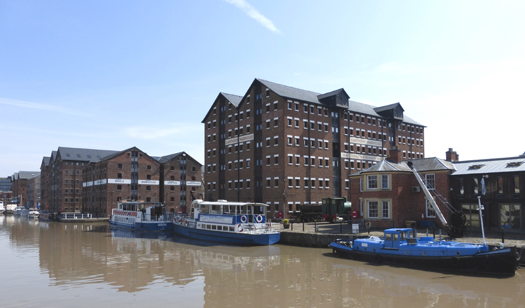
Gloucester's historic docks provide a home for the Nielsen company, specializing in work on tall ships. Photo: W M Nixon
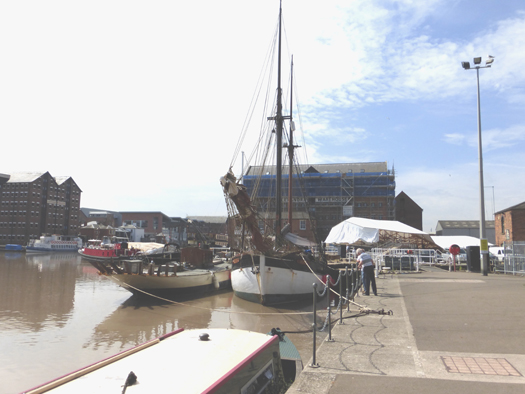
There's always something of interest in the Nielsen corner in Gloucester, in this case a Victorian yacht awaiting restoration beside a Baltic ketch, while in the foreground is a narrowboat from the English canals. Photo: W M Nixon
This is big boy's territory – you get an appreciation of the scale of the Nielsen operation by realizing that one of the smallest craft they've worked on in Gloucester recently was the 52ft 1911-built Bristol Channel Pilot cutter Hirta, which had a complete re-build to emerge as new, and under her original name of Cornubia. A long time ago, Hirta was owned by Tom Cunliffe, who bought her in Scotland in 1982 and called into Howth on his way south at the beginning of a very productive partnership which included a Transatlantic cruise by the northern route. But pilot cutters, like Galway Hookers, weren't built of materials which were expected to last for ever, so it's good news that the Cornubia had this re-build completed in 2010, and is now based at Plymouth under the ownership of the Bristol Channel Pilot Cutter Trust.
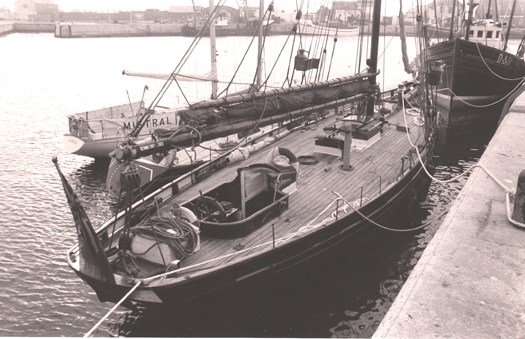
The 52ft pilot cutter Hirta in Howth in 1982. She has recently been re-built in Gloucester, and now sails under her original name of Cornubia. Photo: W M Nixon
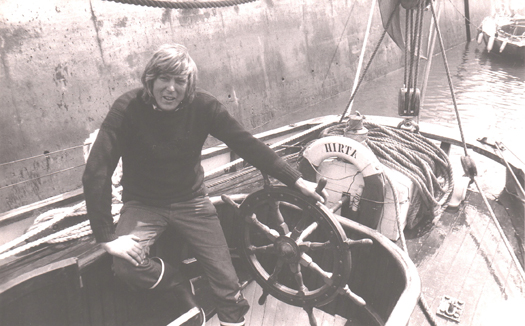
Tom Cunliffe, distinguished maritime writer and former President of the Old Gaffers Association, aboard Hirta in Howth in 1982. Photo: W M Nixon
The Nielsen people were in more familiar size territory when they did the lofting and made the rig for the Jeanie Johnston, and when we were there, they were busy with a major restoration on the Kaskelot, the three-masted 153ft Danish-built barque which was in one of the two dry docks, while other interesting craft at various stages of work were afloat in the dock.
Gloucester is where the heart of the country interacts with the sea, but in order to reach it from the Bristol Channel, vessels have to transit the long ship canal along the Severn valley up from Sharpness, which means that when you reach Gloucester, there's no question of people being impatient to nip out for a day sail – this is a place for working at seagoing ships. Yet Gloucester is also a port on England's myriad of inland waterways, in fact for a period it was an unrivalled entrepot for waterborne trade. But the historic docks are so perfect in their completeness that you get the feeling the burghers of Gloucester must have been on the very cusp of finishing this state-of-the-art waterways centre just as the railways were beginning to make such places redundant, and subsequent generations must have been tempted to flatten the impressive warehouses and fill in the basin.
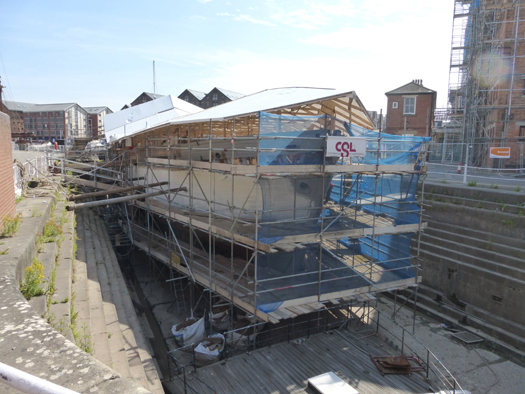
The three-masted barque Kaskelot undergoing major work in one of the Gloucester dry docks. Photo: W M Nixon
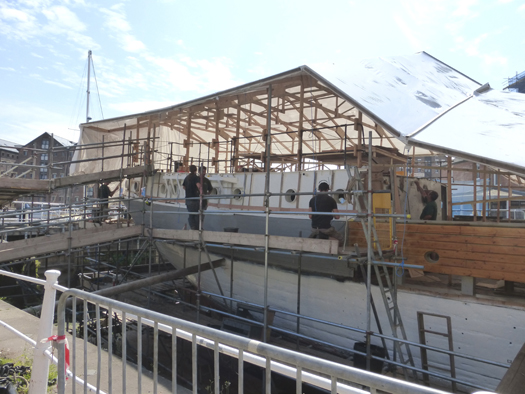
Even on a Saturday morning, there's plenty of work going on for tourists to watch.....Photo: W M Nixon

.....and there's a helpful information board to give you the dimensions of the ship in the dry dock.......Photo: W M Nixon
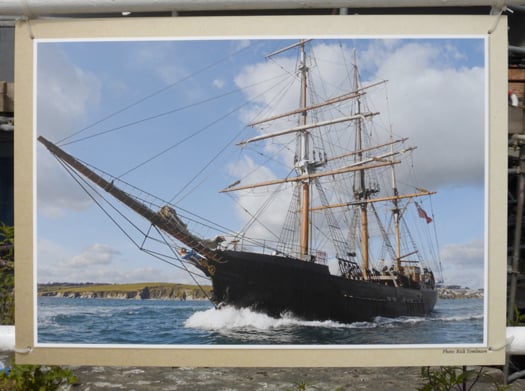
....and there's even a photo to show you what she'll look like when the job is finished. Photo: W M Nixon
But miraculously Gloucester docks have survived, and not least of the elements in their current regeneration is the interest and energy of the Nielsen yard. We were there on a Saturday morning, yet they were busy on the Kaskelot. I didn't dare ask if it was a stipulation of their contract for having the use of the quayside and the dry docks, that they should continue working through the weekend when visitors are about. No doubt about it, the public loves work – they could watch it all day. And what used to be demanding and sometimes dangerous work is now a matter of recreational viewing. Who knows, but some time in the distant future, the government of Bangladesh may think it sensible to pay grants to the families who currently break up ships by hand on the shore of the Indian Ocean, in order to encourage them to continue their lethal but fascinating work for the edification of tourists.
Is This The Oldest Yacht in the World?
#oldestyacht – Serenely she sits, with all the heightened elegance of a still beautiful grand dame who, despite a hectic youth, has lived long and well to take her place in a position of respect, verging on reverence, within the community. But then anyone, whatever the life they may have led, would be deserving of some sort of special appreciation if they'd managed to reach the age of 224 still in reasonably good order, still looking much as they did more than two centuries ago. Yet that is the case with the 26ft schooner yacht Peggy. When you attend upon her in her home in Castletown in the Isle of Man, it's as if time has stood still since the 1790s.
We sailed over to the Isle of Man recently for the Peel Traditional Boat Weekend. As it had been expanded to include the final Irish Sea gathering for the Old Gaffers Association Golden Jubilee, it was felt that the least we could do, before the revels began, was to pay our respects to the ultimate old gaffer of them all, across at her home port on the south coast of the island. And if the Peggy of Castletown isn't the oldest yacht in the world in more or less intact order, then we'll be fascinated to hear of any vessel having a better claim. For by any standards, the Peggy is extraordinary.
Thus we'll leave an account of the fantastic party in Peel for another day. It will be ideal for the depths of winter when such memories of enjoyment deserve to be savoured at leisure. But the Peggy deserves to be highlighted right now. For the fact is that if you're into boats and those who sailed them and their history, then the Peggy blows your mind. The story of her origins, of her adventures in sailing, and of how she has survived for more than 200 years, would the stuff of legend if it didn't happen to be completely true.
The story of the Quayle family of Bridge House right on the harbour in the ancient Manx capital of Castletown is long and distinguished. In the 18th Century, John Quayle was a leading figure in the administration of the Isle of Man. But though his son George Quayle (1751-1835) was a member of the Manx parliament, the House of Keys, for 51 years, he was also something of a Renaissance man, his interests as a successful merchant and ship owner including the co-founding of the Isle of Man's first bank, while his inventive talents were such that he won a gold medal of the Society of Arts.

George Quayle (1751-1835)
Despite the challenging nature of the waters around the Isle of Man, he was also an enthusiastic amateur sailor. So when the impressive Bridge House was being completed in 1789, he saw to it that its eastern end included a private dock accessed through an arch from Castletown Harbour, the dock in its turn giving access to a "boat cellar" in which he planned to have slipping facilities for a 26ft sailing boat he was having built nearby.
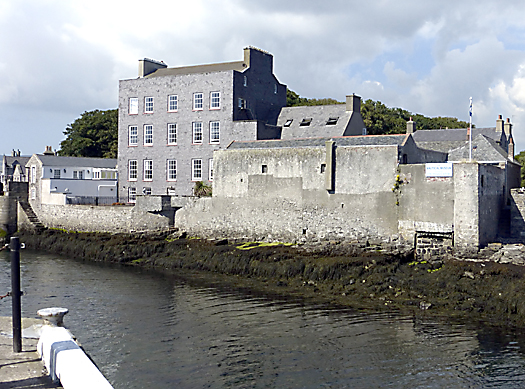
Bridge House, Castletown, IOM. George Quayle's quarters were on the right hand side of photo, and the blocked-off entrance to the Peggy's dock is at lower right. Photo: W M Nixon
It may well be that, like the J/24 some 174 years later, the size of the new boat Peggy was dictated by the size of the garage available. Whatever, there's no doubt she's a very neat fit in the boat cellar. George Quayle then provided a complete maritime unit around his new boat's berth, as he created his own personal quarters around it independent of the family home, the main feature directly above the Peggy's cellar being a fine living room replicating the Great Cabin of a sailing ship.

The first sight of the Peggy when you descend to the boat cellar is memorable, though it takes some time to grasp that this is a boat built 224 years ago. Photo: W M Nixon
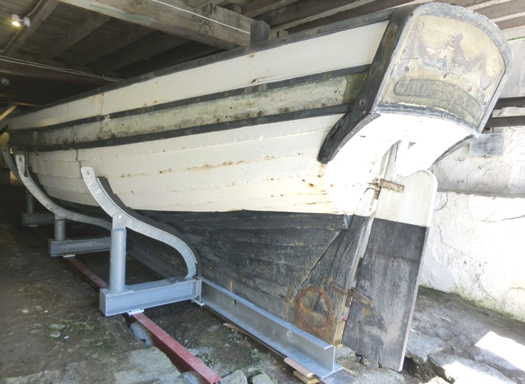
The stern is completely typical of its era Photo: W M Nixon
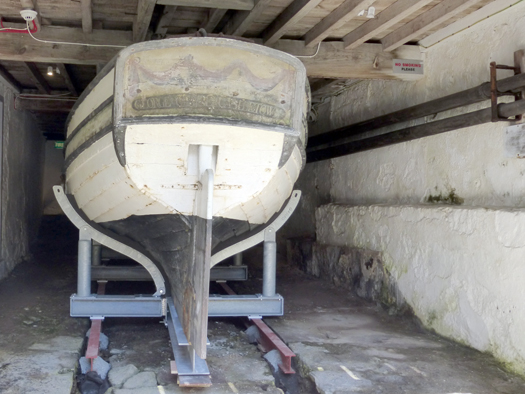
The sections reveal a hull with real speed potential. Note the original spars stowed on wall on right. Photo: W M Nixon
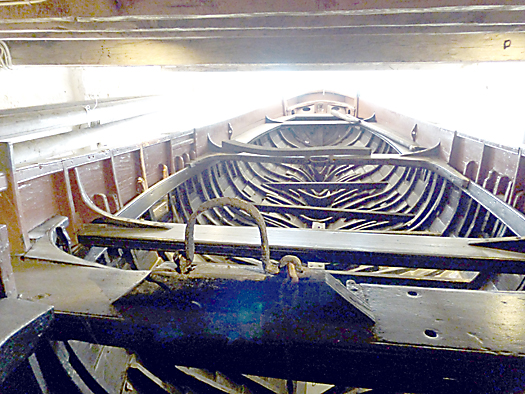
The interior reveals how the topsides were raised to increase sail carrying power. Photo: W M Nixon
With his new boat comfortably housed, and his own quarters cleverly created to shelter him from the demands of busy family life, most folk would have taken things easy for a while. But George Quayle was a bundle of energy. Although the boat was built in 1789, with the demands of completing the big new house, he doesn't seem to have started sailing the Peggy – named after his mother – until 1791. But once she was in action there was no stopping him, both in spirited sailing, and in re-configuring the boat to improve performance. So although the lower part of the hull of the Peggy is probably much as it as when she was built in 1789, as he increased the sail area of the already massive schooner rig he also raised the topsides in order to carry the extra cloth without having her fill. Even then, he still had extra canvas "boards" to keep the sea at bay.
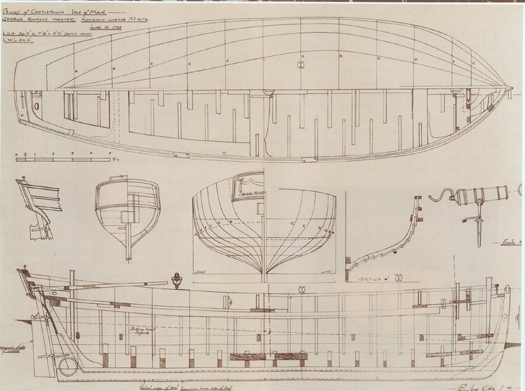
The construction details and hull lines were taken off in the 1930s after Peggy had been released following a century of entombment
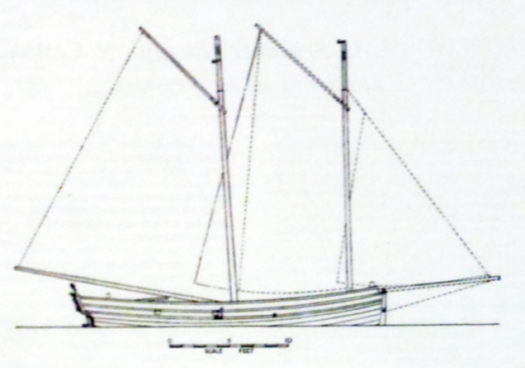
The sail plan is arguably a primitive version of that set by the schooner America 55 years later
The Peggy – complete with miniature yet very real armaments, as French privateers were active in the Irish Sea – was always considered a yacht, and Quayle was keen to race her and further improve performance. Thus he was soon experimenting with "sliding keels" to combat leeway, and the reputation of the Peggy became such that a challenge was set up to sail in a regatta against the only flotilla of other racing yachts within reach, across at Windermere in the English Lake District.
George Quayle was related to a leading figure in Windermere sailing, John Christian Curwen, who had a couple of sailing pleasure boats imported from the Baltic. Also on the lake was a supposedly hot sailing machine owned by one Captain Heywood. So in 1796, Peggy sailed across to Cumbria, and was carted up the half dozen or so miles from the inner reaches of Morecambe Bay to the lake, which is 128ft above sea level.
It was quite an effort, and as yacht racing organisation was only in its infancy in 1796, the results weren't totally clearcut, though it seems that the Peggy outsailed everything else by several country miles. Intriguingly, two other boats from this pioneering regatta have also survived, though not so well as Peggy. These were the two Baltic boats owned by John Christian Curwen. They were still intact until the 20th Century, but then were fire-damaged while in store. The sad remains of both were on display in a corner of the Windermere Steamboat Museum when I was there around twenty years ago, but largely ignored. Much more interesting was the discovery that George Quayle's relation John Christian Curwen was in turn related to Fletcher Christian of Bounty notoriety, who was of course a Cumberland man. Up among the lakes, they were happy to tell us that there's no way Fletcher Christian stayed on Pitcairn until the end of his days – he got home to the lakes some way or other, so it's said.
But meanwhile the Peggy only just made it home to the Isle of Man after her successful foray to Windermere. She'd a real pasting in the Irish Sea beating back to Castletown, but in typical style George Quayle turned this to best advantage, cheerfully reporting in a letter that the "sliding keels" so improved windward performance that they safely made it back to port.

The sailplan on the model is one interpretation of the abundance of spars available in the boat cellar Photo: W M Nixon
Today, in the boat cellar at Bridge House, you can see the Peggy and all the features which made her such an able flyer. She still has the slots through which George Quayle lowered his primitive centreboards, and on racks on the wall are the original spars she carried when in her racing prime. This indeed was and is a formidable racing machine, and it's no exaggeration to assert that, in her miniature style, she was an early example of the type which reached its supreme development with the schooner America.
And she has survived through a fortuitous miracle of preservation. The exact timing and circumstances in which it all happened are not precisely clear, but we know that after George Quayle died in 1835, the Peggy was entombed in her boat cellar, with the seaward entrance walled up. In time, the little dock was filled in, and the archway through to Castletown harbour closed off. Yet with the pervading salty air, this provided an ideal environment for boat preservation. When it was all opened up again in the 1930s, there was the Peggy, still in remarkably good order, still the same little ship which had successfully completed such a gallant expedition to Windermere in 1796.
Today, George Quayle's quarters in Bridge House accommodate the Manx Nautical Museum, with the Peggy – now formally owned by the Manx nation - the prime exhibit. But with every passing year, she becomes ever more important, so much so that 2014 will see a comprehensive project to conserve her, and in time - let us hope - put her on more accessible display with her full racing rig in place.
With imaginative design, it could possibly be done by putting a clear roof over the little dock. I didn't pace it out when we were there a couple of weeks ago, but guessing from the photos, it should be just about feasible to accommodate her there with all sail set.
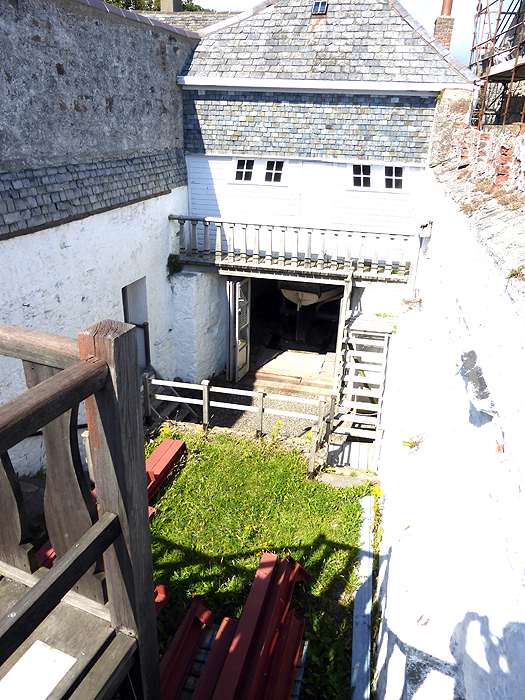
The former dock, now filled in, where Peggy was berthed before hauling into the boat cellar - note her stern just visible in doorway, while the windows in the room above reflect sailing ship Great Cabin style. This former dock could be re-configured for use as a covered display area where the newly conserved Peggy could be put on show fully rigged. Photo: W M Nixon
And after 224 years, she surely deserves a proper display. But for now, there are the intriguing challenges of conservation. Most of the timber is in remarkably good order, but the fastenings need replacing, as apparently they are "mineralising". That sounds remarkably like good old-fashioned rust to you and me, but "mineralising" is a word to cherish. So it won't surprise you to learn that, after the earnest piety of our visit to the Peggy, my shipmates then threw themselves into the festivities and fabulous hospitality of the Peel Traditional Boat Weekend with such enthusiasm that we were undoubtedly in a mineralised condition as we slugged our way back home across the Irish Sea.
Half Ton Classics 2013 – Yacht Racing on the Level?
#halfton – As we digest the multiple results of the Rolex Fastnet Race and run the effects of different measurement rules and allowance systems over the elapsed times of a fleet of almost absurd diversity, it is only natural to wish for some simple system whereby first past the post is the winner, and that would be the beginning and end of it. Yet there's something about offshore racing which makes the notion of using straightforward one-design boats a concept of only limited appeal. The sea itself is an environment of such diversity that it seems to call out for a variety of boats to sail upon it, while the people sailing those boats are of course ludicrously individualistic.
Not that there haven't been attempts over the years to introduce one design offshore racing classes. We'll see it again soon with the new Volvo boats, and at the moment the superb MOD 70s are showing just how attractive the one design ideal can be. But it's nothing new. In fact, the idea of one designs capable of going offshore racing goes back beyond the establishment of "ocean racing" as we know it in Europe today, and was in evidence in America when Thomas Fleming Day inaugurated American ocean racing with the first Bermuda Race in 1906 with three boats which were all totally different, and two of them finishing the course.
In the golden age of sailing development from around 1890 until the outbreak of the Great War in 1914, several noted designers and builders on both sides of the Atlantic produced one design boats which were capable of racing offshore. One of the first was the Belfast Lough Number One Class of 1897, designed by William Fife, the design (slightly modified) being adopted the following year as the Dublin Bay 25. At 37ft LOA and 25ft LWL with a proper if decidedly Spartan cabin, they had the potential to be fast cruisers which could be offshore racers.
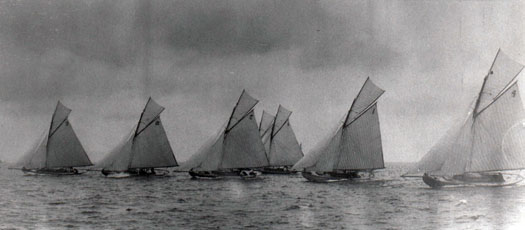
The new Belfast Lough Number Ones racing in 1898. They had the potential to be one design offshore racers, but the sport hadn't yet been invented. Photo courtesy RUYC
Except that the concept of offshore racing as we know it today simply didn't exist. For sure, you'd things like the Royal Alfred YC's Channel Matches between Dublin and Holyhead from the 1870s onwards, and there were also some coastal passage races. Then too, boats like the Herreshoff-designed New York 40s could take part as a class in events like the NYYC annual summer cruise. But the notion of a one design boat which could perform well while staying at sea for prolonged periods with the crew sleeping on board - whether at sea or in port - was not really on the agenda at all until around 1909, when the designs for the 11-ton yawls of the Belfast Lough Island class were commissioned from Alfred Mylne of Glasgow.
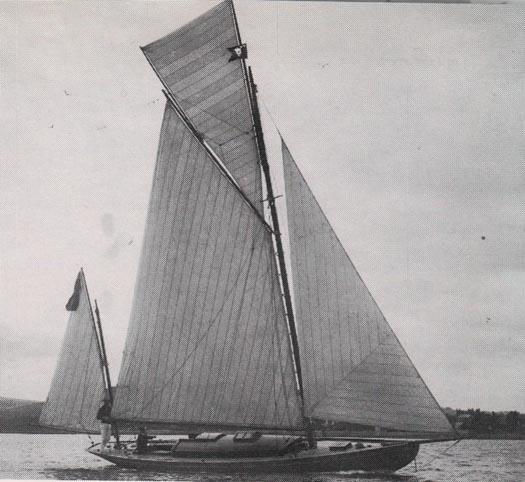
The Belfast Lough Island Class yawl Eriska in 1911. This was one of the first serious attempts to create a one design cruiser-racer class. Photo courtesy RNIYC
This was to be a one design class which could be used for regular club racing while at the same time providing sufficient comfort for the annual two weeks cruise to the Scottish West Coast which was the staple of Belfast Lough sailing, with the additional option of taking on cross channel races to the Clyde or Portpatrick.
It was one very crowded design brief. And with half a dozen potential owners making their personal views felt, plus the fact that the builder was John Hilditch of Carrickfergus, who was no stranger to controversy, creating the new class was a tricky business.

The Island Class Trasnagh winning the cross channel race to Portpatrick in 1925 Photo courtesy RUYC

The offshore one design dream briefly fulfilled – five boats of the Belfast Lough Island Class in Portpatrick in 1925 after racing from Bangor. Photo courtesy RUYC
There's also a feeling that Alfred Mylne, arguably the best of the Scottish designers after the death of G L Watson in 1904, wasn't really giving the task his full attention. In response to the demand for a comfortable cruiser, he certainly designed a boat of considerably more displacement, proportionately speaking, than his racing one designs such as the Dublin Bay 21s. Yet if anything the new Island Class boats seemed to have lower freeboard than many Mylne designs of comparable size, and they undoubtedly were very low slung in their later years when auxiliary engines and other additional cruising comforts were added.
Thus in full cruising trim, they could be extremely wet to sail aboard. I can remember as a kid being on the old Island Class yawl Trasnagh as we went through the Ram Harry tide race northeast of the Copeland Islands at the entrance to Belfast Lough. It was a bit startling to be sitting in a cockpit suddenly full of water. But owner Billy Barnes was completely unfazed by this state of affairs – that's the way it was with the Islands, but it meant their self-draining cockpit was an essential.
Then too, while they may have been a gallant pioneering attempt to transfer the one design ideal to a cruiser-racer, being Belfast Lough the owner's group managed to fall out with the builder. Hilditch wanted £350 per boat, but the owners wouldn't go a penny over £345. The argument dragged on until eventually Hilditch said he would build the boats for £345, but their stems would have to be markedly snubbed in order to save money.
Presumably the original line of the stem was an elegantly drawn-out overhang in much the same style as the Dublin Bay 21. But nevertheless, how any money could be saved by making it an awkward little tight curve in a distinctly spoon bow profile is difficult to believe, and those not directly involved reckoned it was a classic case of cutting off one's nose to spite one's face.
Be that as it may, by 1913 the Islands had six boats racing, and they were an impressive sight in regular action off Cultra and Bangor, and at Belfast Lough regattas. Several also appeared at the Clyde Fortnight, taking the crossing of the North Channel comfortably if wetly in their stride. But the prospect of the continuing growth of the class was brought to a halt by the Great War of 1914-18, and after it the heart had gone out of much of sailing in the Belfast Lough area until things slowly picked up in the 1920s.
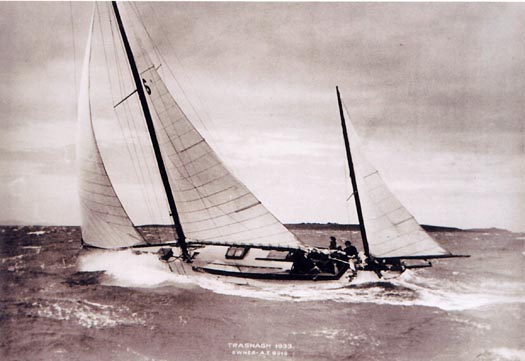
Wet but fast – Island Class yawl Trasnagh powering through Donaghadee Sound in 1933 under her new Bermuda rig Photo courtesy RNIYC
Like many other classes, the Islands faced demands for a changeover to Bermudan rig, and they suited it well, though when some owners went all the way and removed the little bowsprits in the interests of a more modern appearance, the result was a boat which hung on her helm like a ton of bricks.
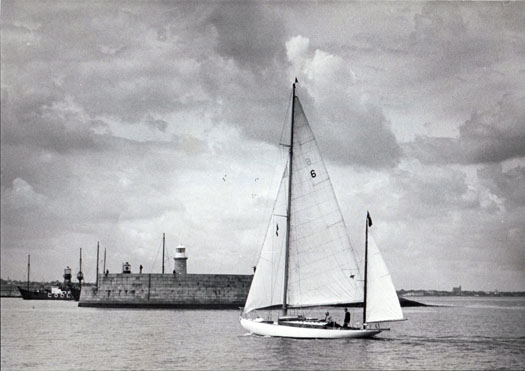
Trasnagh entering Dun Laoghaire in 1980 in her later days under Bermuda rig and without the bowsprit, showing how little freeboard the boats had with an added auxiliary engine and other cruising equipment. In recent years she has been re-built in Devon, with her original gaff configuration restored. Photo: W M Nixon
By the 1930s, other areas were looking seriously at the notion of club one designs which could also race and cruise offshore, and the idea of the Bermuda-rigged Dublin Bay 24 was first mooted in 1934. Seldom can a class have had a longer gestation. This time it was World War 11 from 1939 to 1945 which brought things to a halt, and it was 1946-47 before the 24s were finally sailing on Dublin Bay, and starting to show their potential inshore and offshore.
Across in England, the members of the RORC in its early years after its foundation in 1925 were so individualistic that the notion of an offshore one design simply didn't arise. But then in the grim days of slow recovery after World War II, the great John Illingworth and others shook things up with the Laurent Giles-designed RNSA 24. With a transom stern making them not unlike large Folkboats, these 30 footers could have been a first offshore one design, but of course although the hulls were standard, everything else was different – Bill King, for instance, even rigged his RNSA 24 Galway Blazer as a ketch.
However, there was one little germ of an idea floating around which began to gain adherents, and that was level rating racing. By all means have different boats, but have them designed to rate under the RORC rule to exactly the same rating. It would encourage design development, yet it would produce an immediate winner. It seems such an obviously sensible notion that it's extraordinary to think its appeal is not universal. Yet people are always trying to find ways of shaving a point or two off their rating and getting every advantage from this. And as for boats which simply cry out to be straightforward offshore one designs, such as the great First 40.7, it emerges that few if any of them rate exactly the same.
Nevertheless the level rating ideal goes up the flagpole every so often, and in 1965 it took off in a big way with the re-allocation of a silver cup presented in 1899 by the Earl of Granard (he was to become Commodore of the National YC in 1930) to the Cercle de la Voile in Paris. Initially, the One Ton Cup was for racing on the Seine, then it was raced for by the International 6 Metre Class, and then in 1965 it found new life for an international series, inshore and offshore, for offshore racers rated at 22.0ft under the RORC Rule.
At this distance, it's difficult to imagine the excitement aroused by this new shine on the old cup. Some well-known offshore racers had some very odd things done to them in order to make them fit the very specific rating. But it worked, the idea took off big time, and the spinoffs soon followed. One Tonners were boats around 35-36ft long, Half Tonners which soon followed were 28-31ft, Three Quarter Tonners were 32-34ft, Quarter Tonners were around 25ft, and Two Tonners were 40 – 42ft. They all raced absolutely level in their class, first to finish was the winner, that was all there was to it, and for about twenty years this was the most exciting area of offshore racing.
Irish sailing was much involved, and over the years it was with the Half Ton Cup – boats around the 30ft mark – in which we made our greatest impact. The arrival of Ron Holland in Cork in 1973-74 provided the necessary design skills, and in 1976 Harold Cudmore and a Cork crew went forth on a somewhat shoestring challenge to the Half Ton Worlds in Trieste with the new Silver Shamrock, a re-worked version of the original Ron Holland Golden Shamrock production Half Tonner concept from 1974.
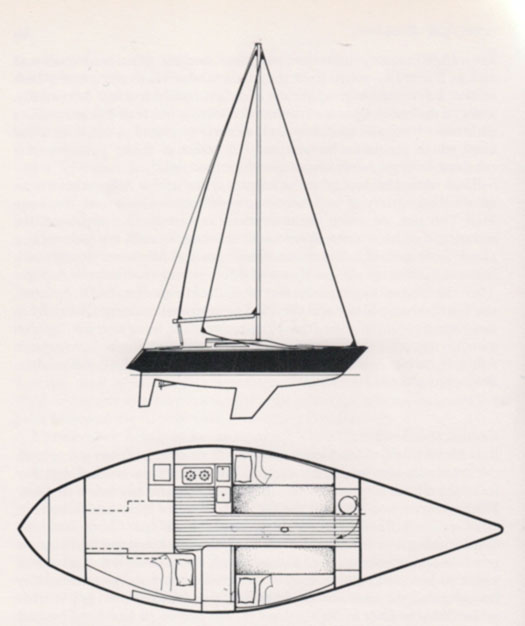
Golden Shamrock, built in Cork, was Ron Holland's first production Half Tonner
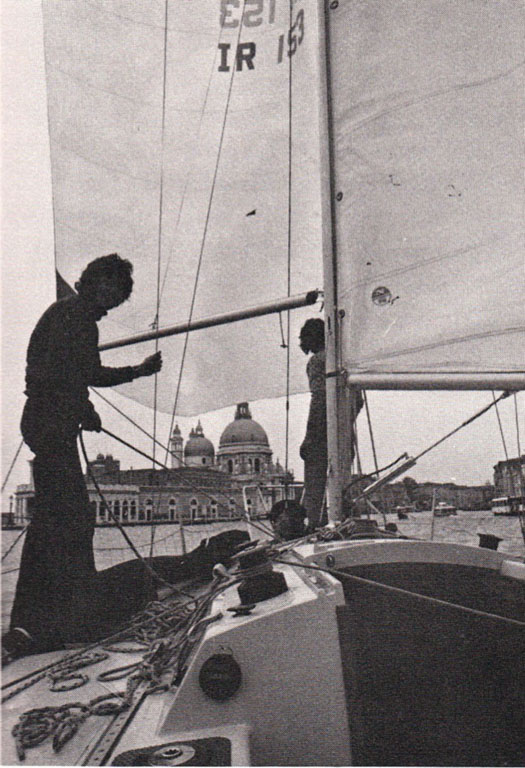
Victory parade. After Silver Shamrock won the Half Ton Worlds at Trieste in 1976, she sailed across to Venice and ran up the Grand Canal under spinnaker. Ronnie Dunphy on left of photo, Killian Bushe behind mast.
Harry Cudmore won a famous victory, and in celebration he and his crew sailed across to Venice and ran up the Grand Canal with spinnaker set. It was his first major international success in what was to become a glittering global sailing career, and as for the Half Tonners, they were firmly set on course to become the most popular of the Ton Cup classes.
During the 1970s and early '80s, fleet numbers were regularly pushing over the 40 mark at the annual World Championship, and though the peak had been 55 boats at Marstrand in Sweden in 1972 (when Paul Elvstrom won), they were still around the 40 mark in the early 80s, and could muster 35 at Porto Ercole in 1985.
The waxing and waning of particular kinds of racing is sometimes incomprehensible. But whatever caused it, the collapse of the Half Ton Worlds as a premier event was sudden and total. There were hundreds of eligible boats around, but with the economic gloom of the 1980s and people's sailing interests focusing elsewhere, as an event the Half Ton Worlds fell off a cliff, with the last one in 1993 at Bayona attracting just ten boats.
The event may have gone, but the many and often gorgeous boats were still very much in existence, increasingly seen as classics, and raced in handicap classes by devoted owners. In 2000 at Cork Week, two of them – the Irish boat SpACE Odyssey (Shay Moran, Enda Connellan, Terry Madigan and Vincent Delany) and the French boat Sibelius (Didier Dardot) decided that a Half Ton Classics Worlds, limited to boats built to the relevant rule between 1967 and 1992, might just be a runner on a biennial basis, and it has proven itself so, with entries two years ago in Cowes topping the 38 mark.
In 2007, it came to Dun Laoghaire with 25 boats providing a feast of nostalgia and great sport. The overall winner was the Rob Humphreys-designed one-off Harmony, owned by Nigel Biggs, who became so hooked on the value of the concept incorporated in this re-birth of the Half Tonner notion that he bought a vintage Humphreys-designed production boat, an MG30, and set about optimising her for racing in a class which is keen enough to make it worth the effort, yet not so excessively competitive as to self-destruct.
The result of the optimisation, which began with a consultation with David Howlett followed by a permitted redesign of the keel and rudder by Mark Mills, with all the ideas then implemented by John Corby at his yard in Cowes (with some of his own notions added), is of course Checkmate XV, the runaway superstar of the Volvo Dun Laoghaire regatta in July, and surely one of the favourites for the Half Ton Classics 2013 which gets under way tomorrow at Boulogne in northern France.
For this event, Biggs' crew reflects his active involvement in sailing on both sides of the Irish Sea. From this side of the Irish Sea, he has recruited regular shipmates Jimmy Houston from RStGYC and Robbie Sargent from Howth, while the other side of the channel brings in longtime sailing friend Pete Evans (they go back to Laser Youth Racing in 1985), and George Rice and Gerry Ibberson.
Since the VDLR in July, Checkmate XV has been undergoing further tuning in her home shed in Cowes, with a smidgin being shaved off her IRC rating. For yes, it has to be admitted that, with the age range of the Half Ton Classics taking in such a wide band from 1967 to 1992, they actually race under IRC on a handicap basis. It sounds crazy. But it works, and the reality is that there isn't more than 30 seconds in any hour between the class rating extremities.

King One for the road, and easily trailed with it – Dave Cullen's former world champion King One will also be at the Half Ton Classics in Boulogne, and has already been successful in the area with a win at Ramsgate Week last year. Photo: W M Nixon
Most of the classic Half Tonners from the era when the class was at its frontline international height are attractive boats, and they're of very manageable size while providing a bit of muscle. Trailering them is a straightforward proposition, and another entry tomorrow of special interest, Dave Cullen's King One from Howth, has made a speciality of sailing in those narrow easterly waters of the English Channel, where she was a participant last year in Ramsgate Week, which she won.
After more than a decade as a biennial event, the Half Ton Classics will now go annual, with 2014's championship already scheduled for Carnac in Brittany. We wish it well. We may have set out this week to follow the storyline of the once fervent hope that there could be genuine one design offshore racers, a hope so continually frustrated that instead people turned to the scope offered by designing different boat to fit one rating band. We have continued our voyage of discovery to find that boats of what was once the world's most numerous level rating class are so different - when all eras are brought together - that the only way they can have meaningful racing is by using the IRC handicap system, just like everyone else. Crazy maybe. But no crazier than the America's Cup.








































































